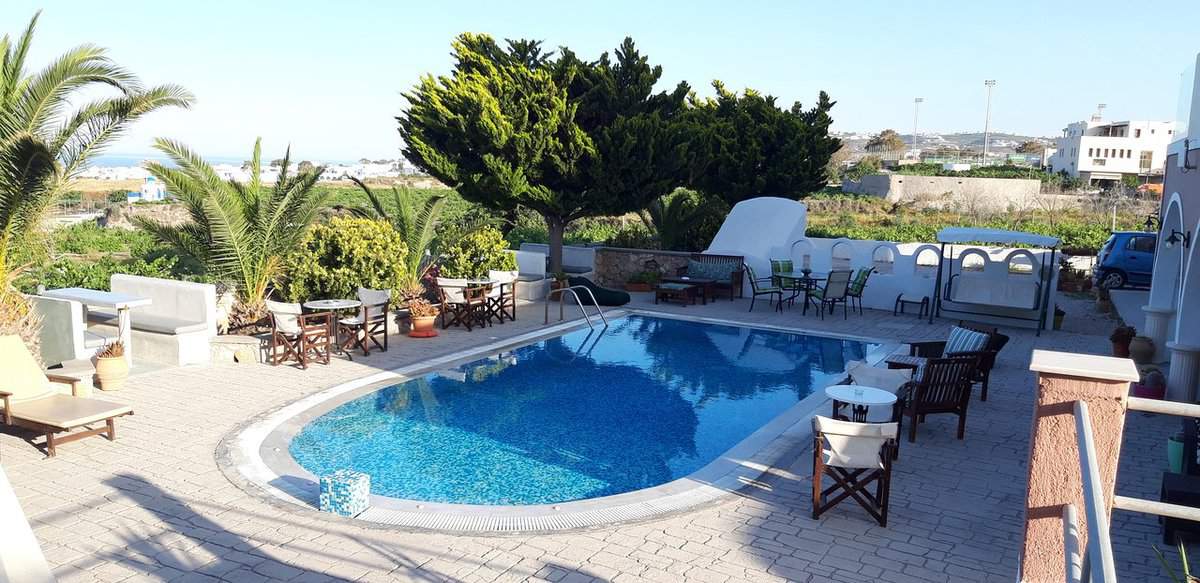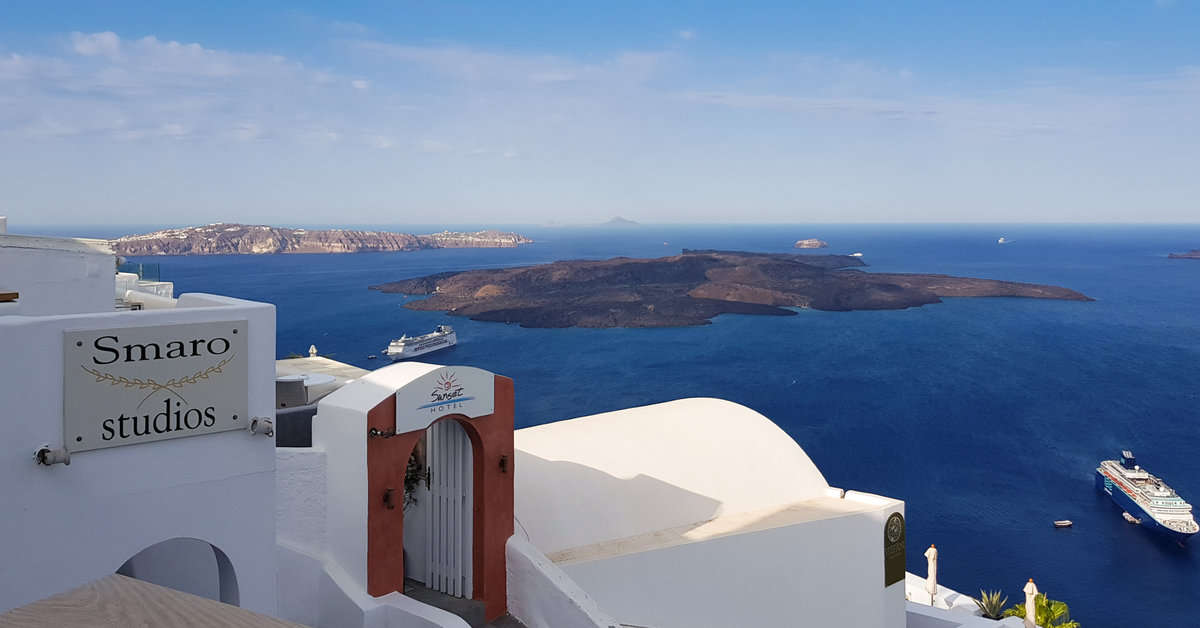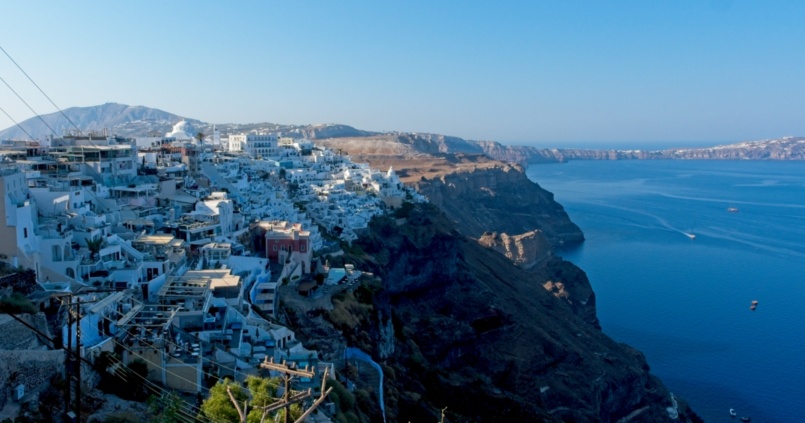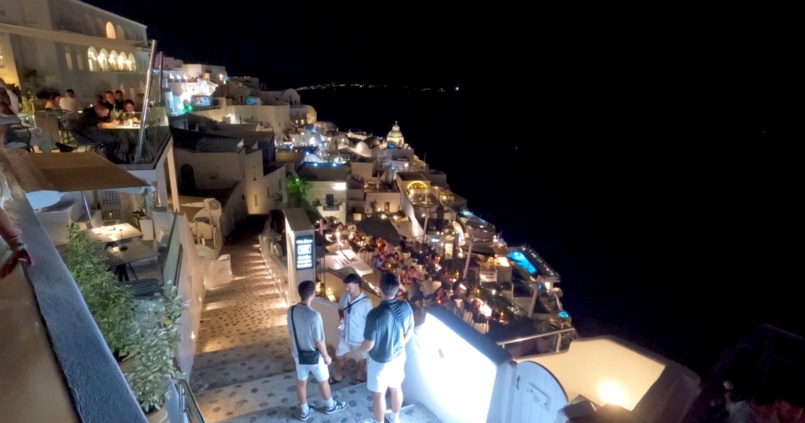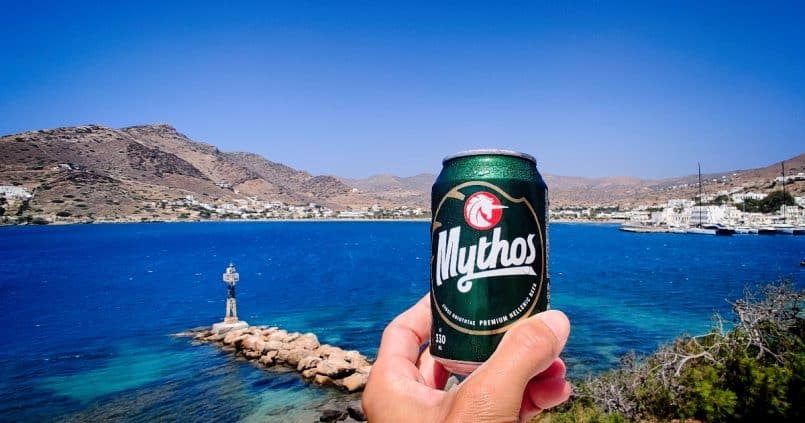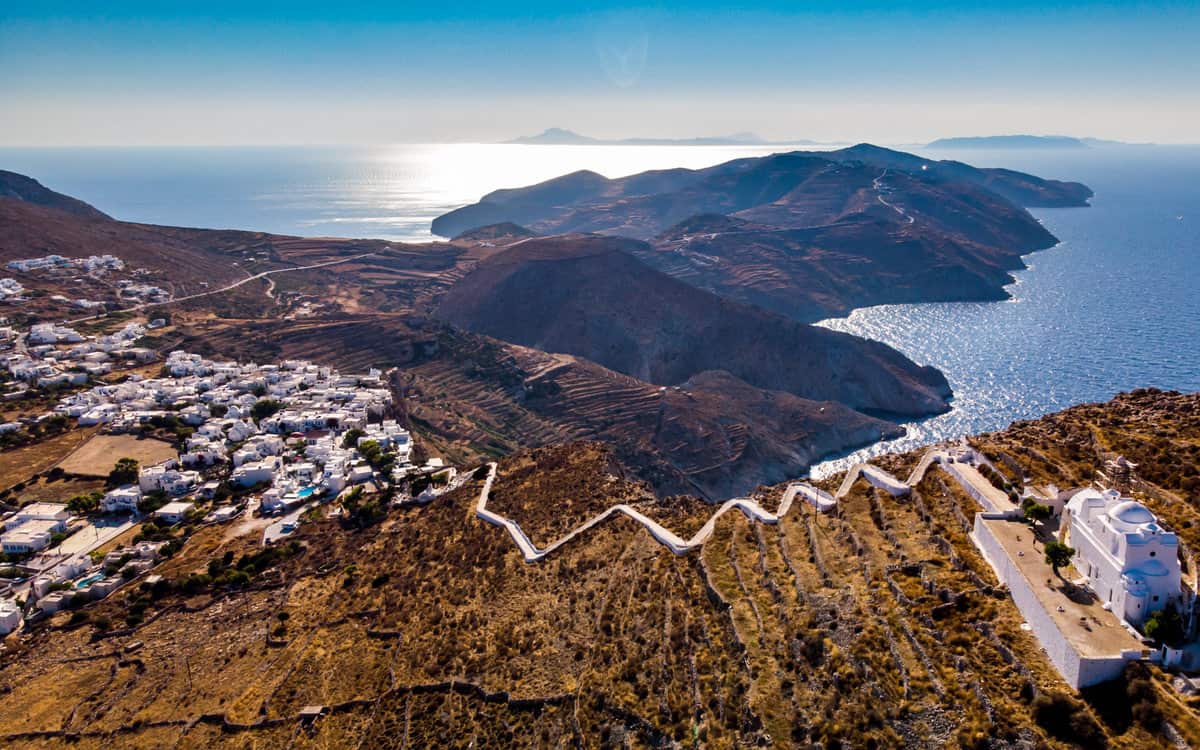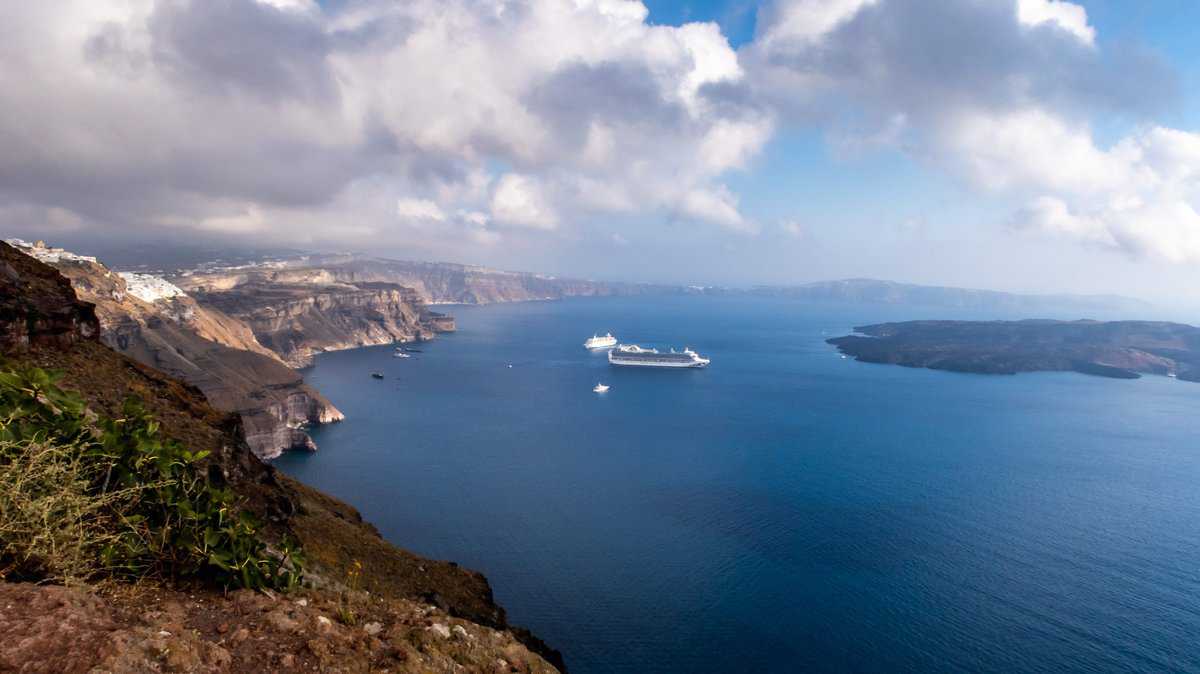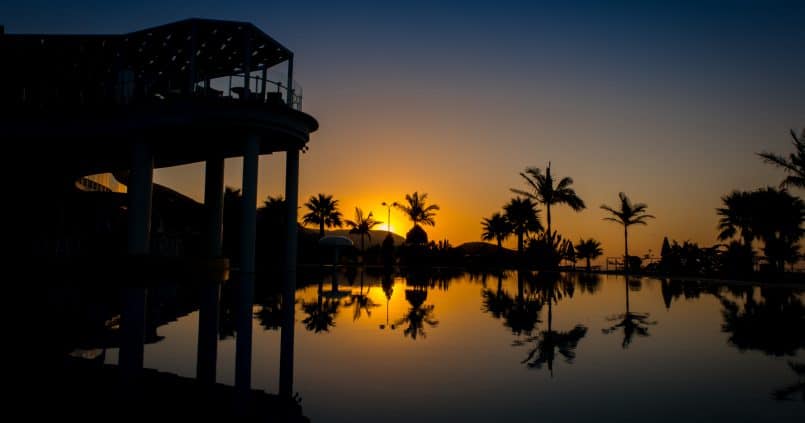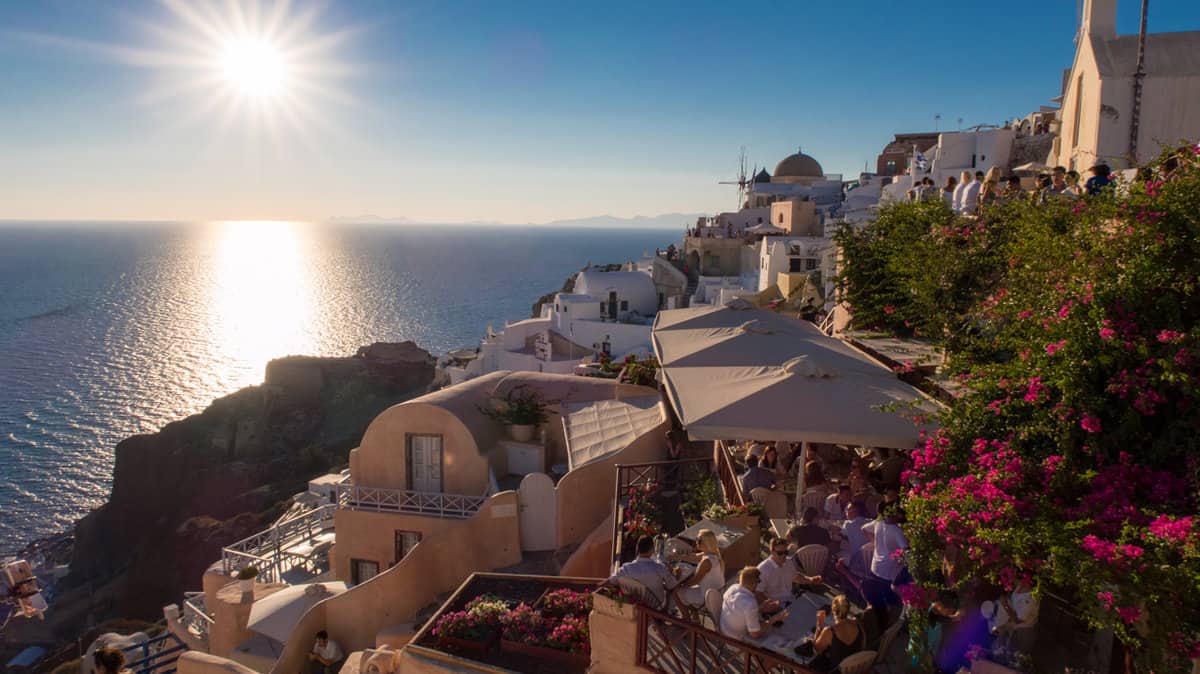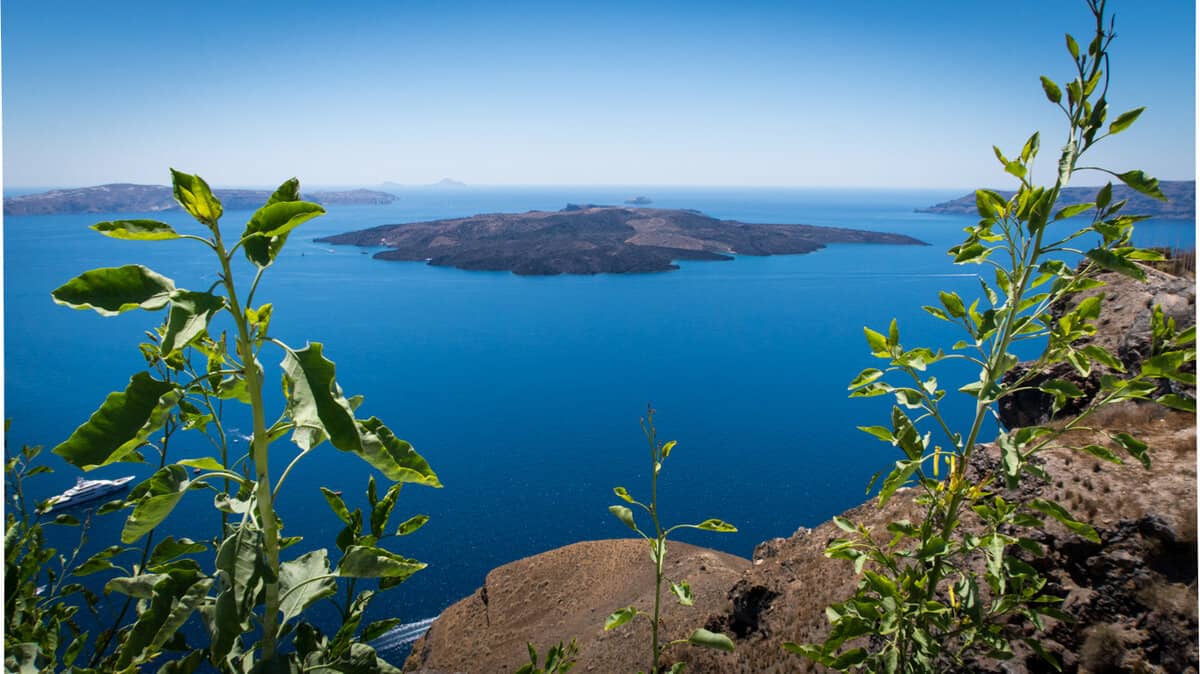
Santorini Island Guide
Santorini Island Overview
Perched above the sparkling Aegean, Santorini is a dream woven in whitewashed villages, sapphire-domed churches, and sunsets that seem almost too beautiful to be real. This island’s dramatic cliffs and volcanic beaches set the stage for unforgettable moments, while boutique hotels, infinity pools, and world-class cuisine offer a touch of effortless luxury. Whether you’re sipping local wine on a private terrace or wandering through charming alleys hand-in-hand, Santorini invites you to slow down, savour every view, and fall in love—with the island, and perhaps all over again.
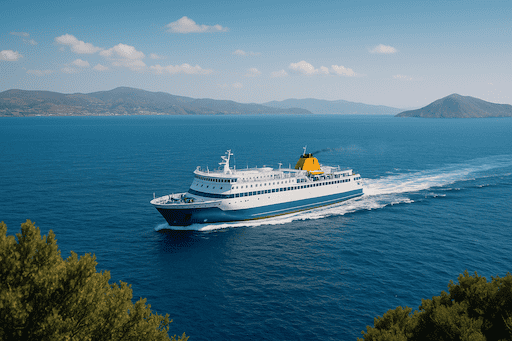
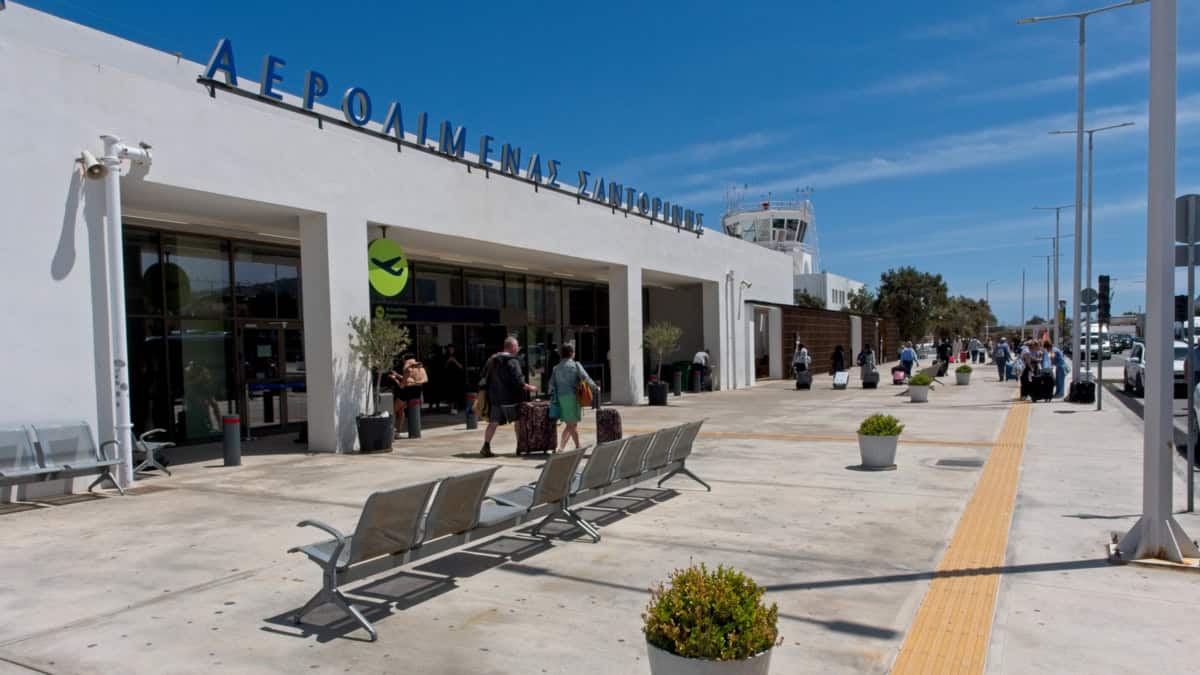

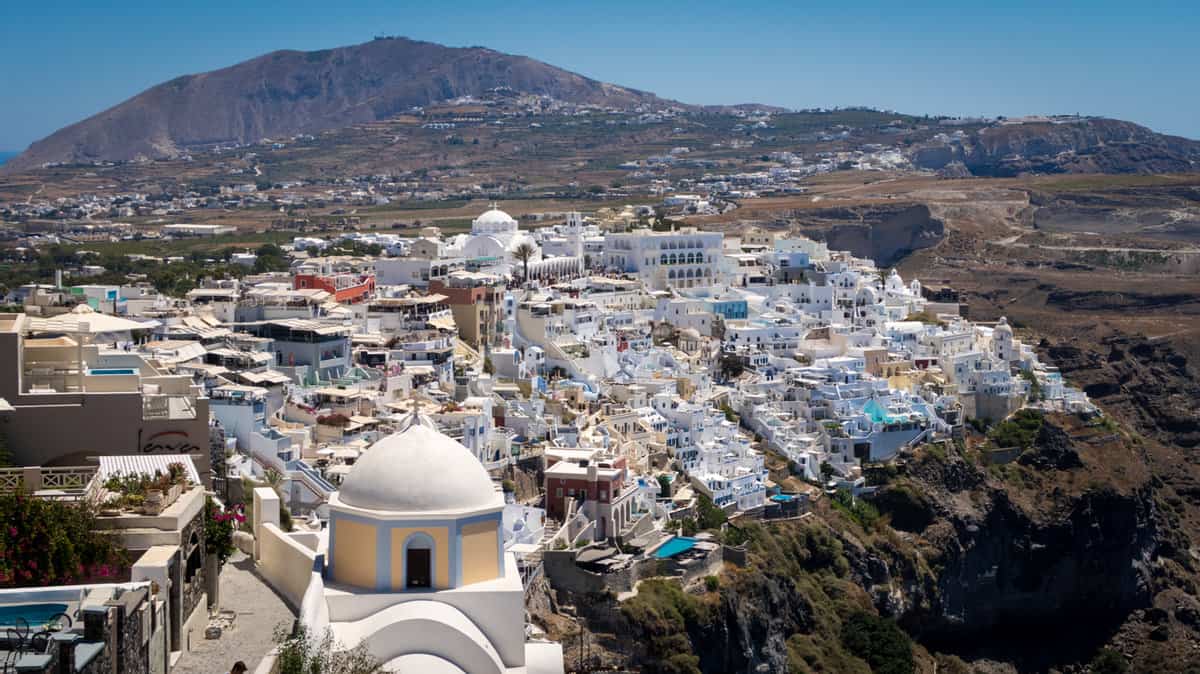
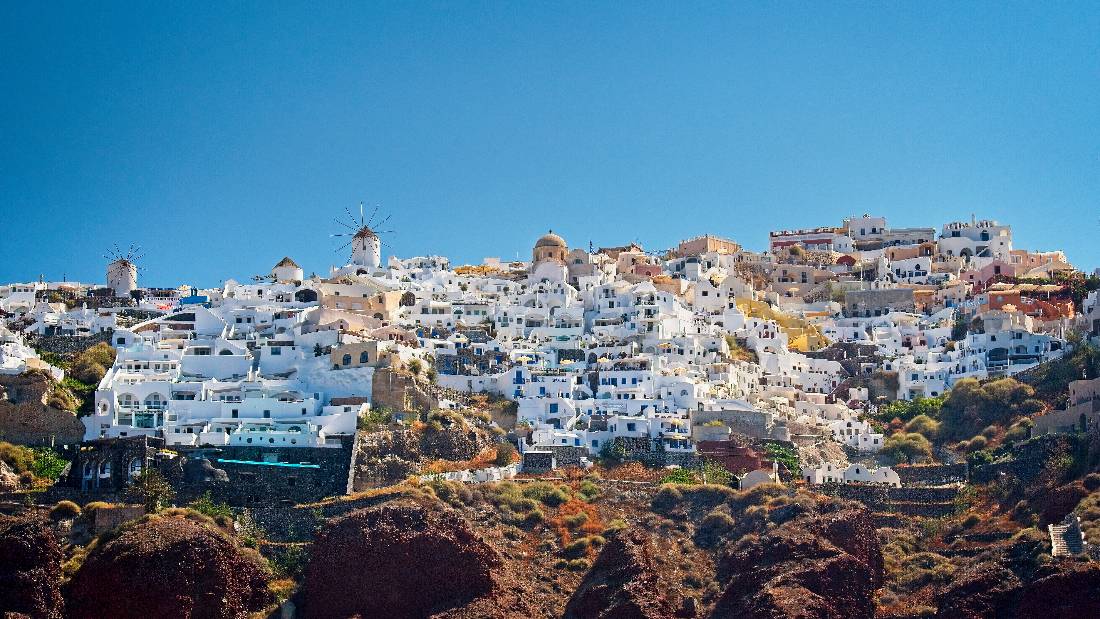

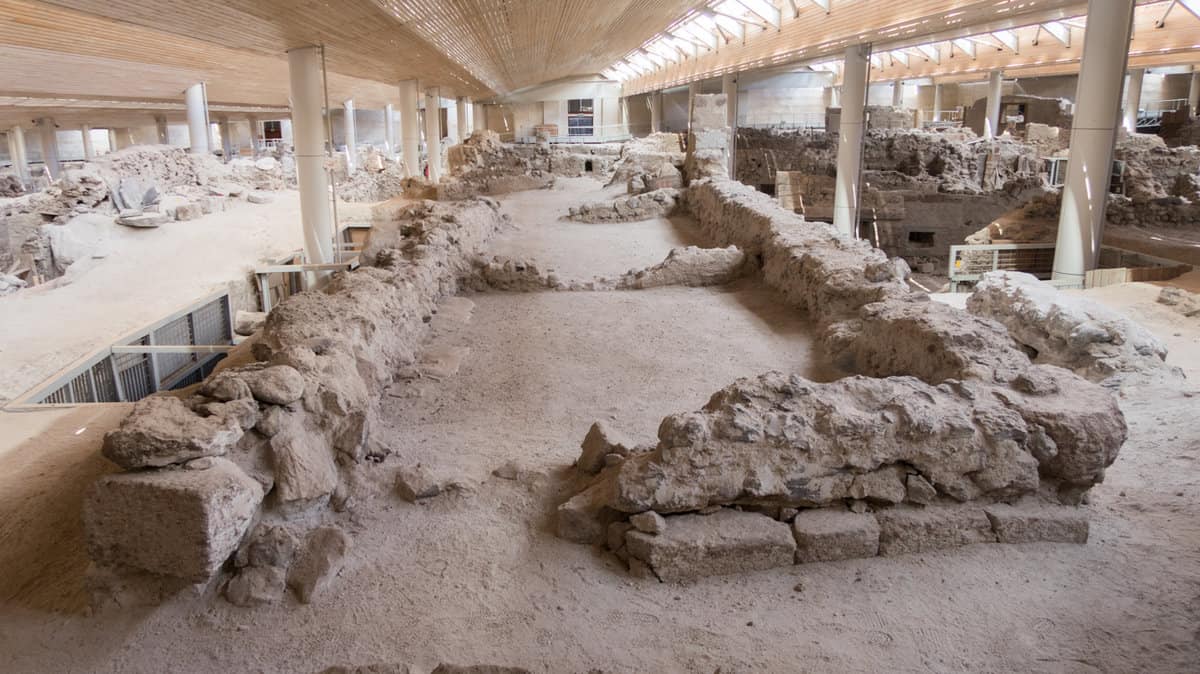
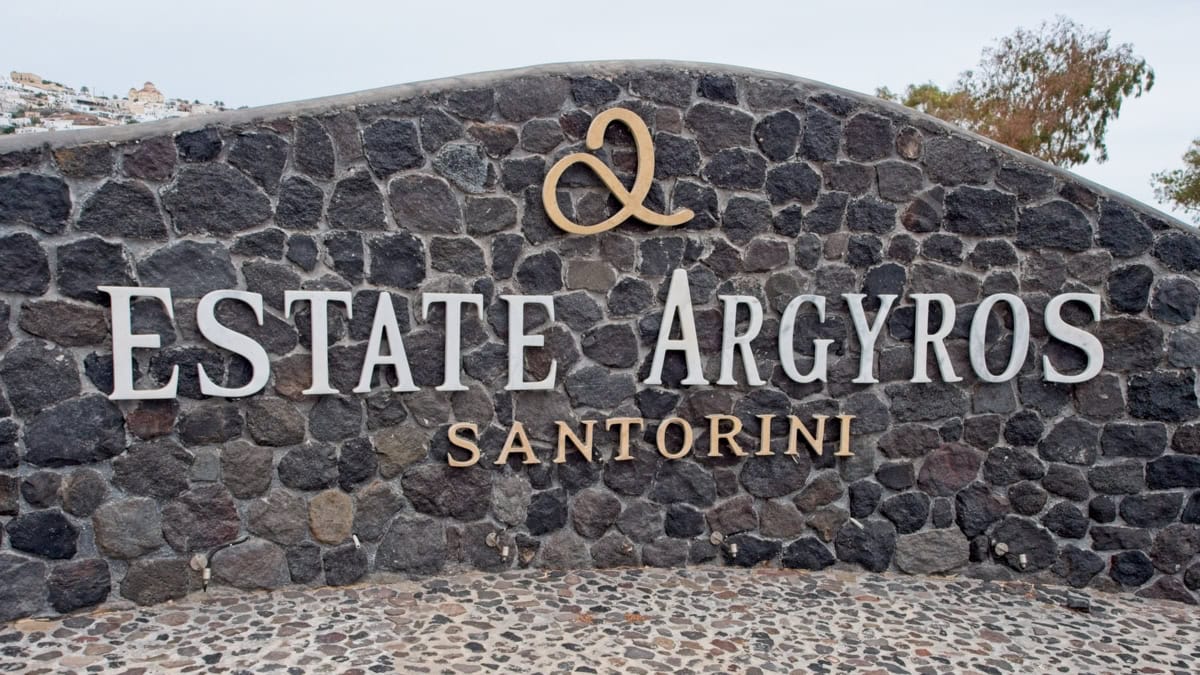


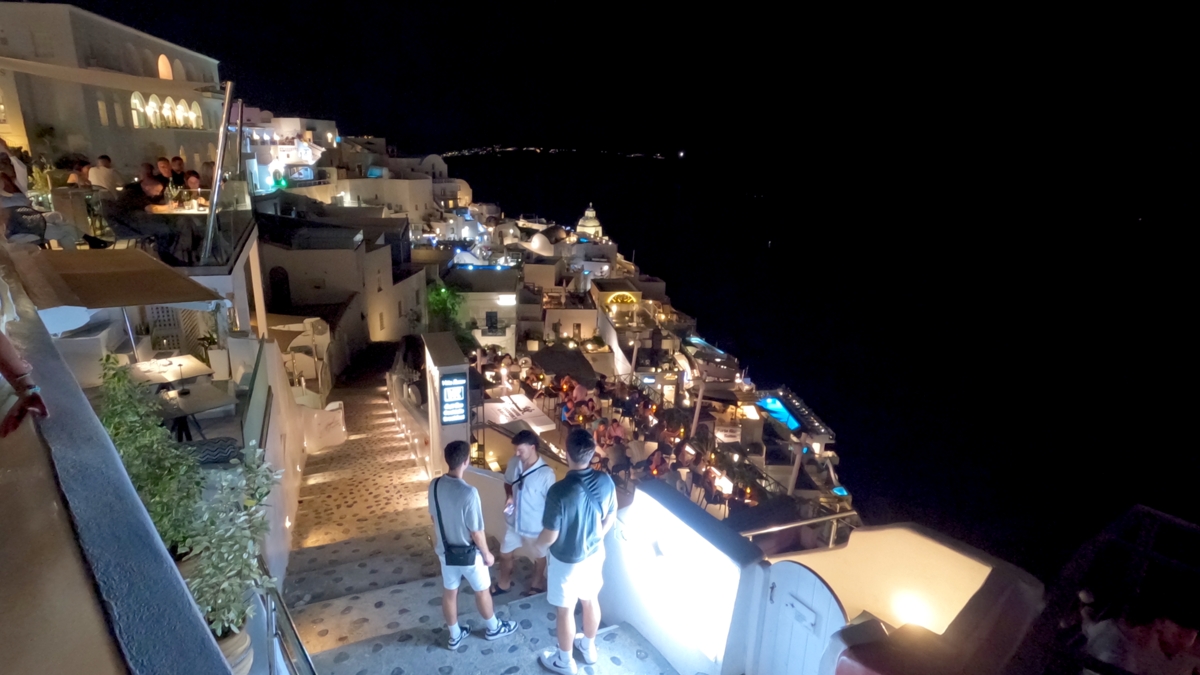

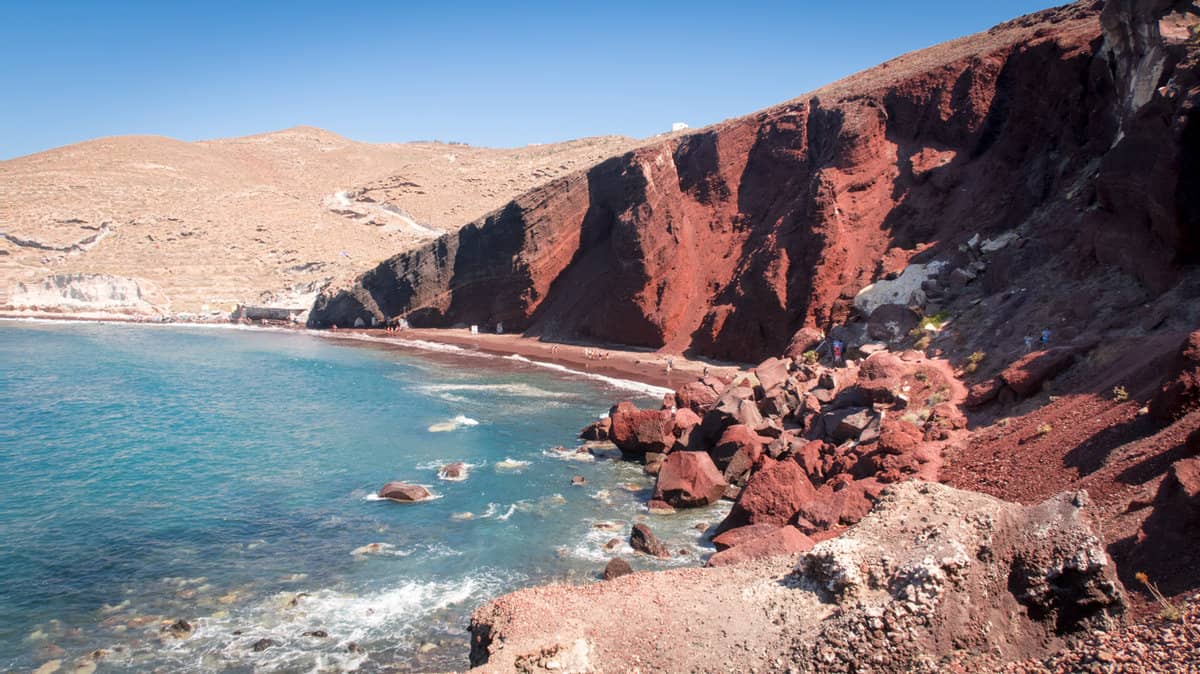
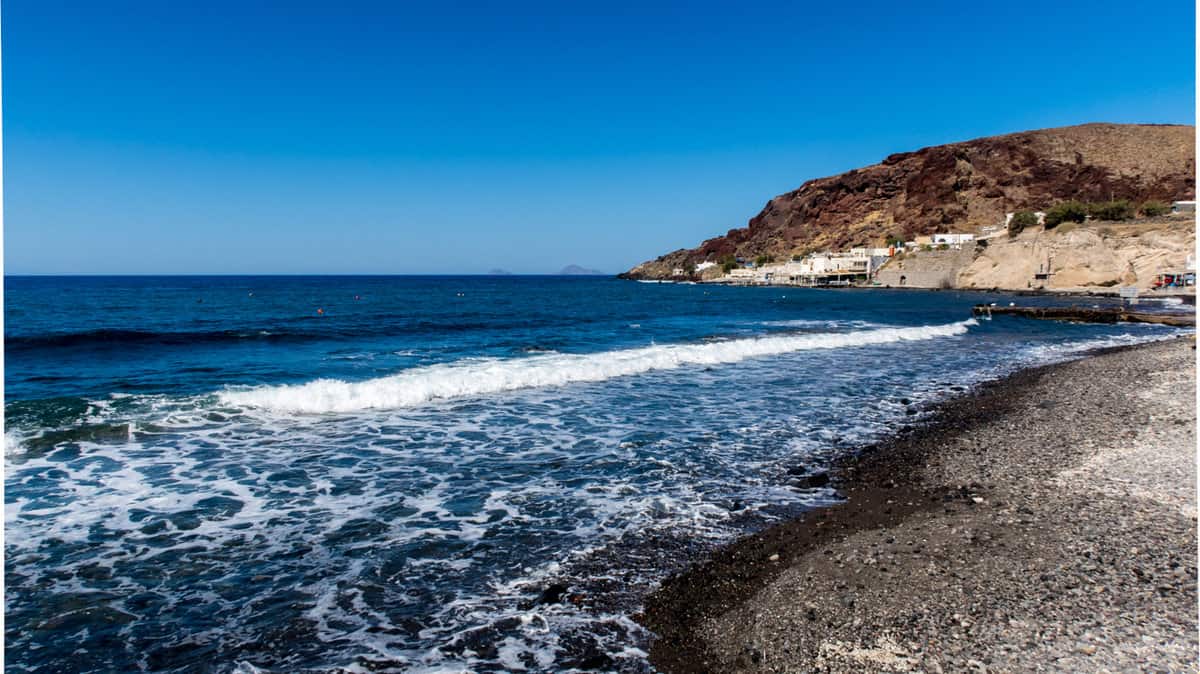

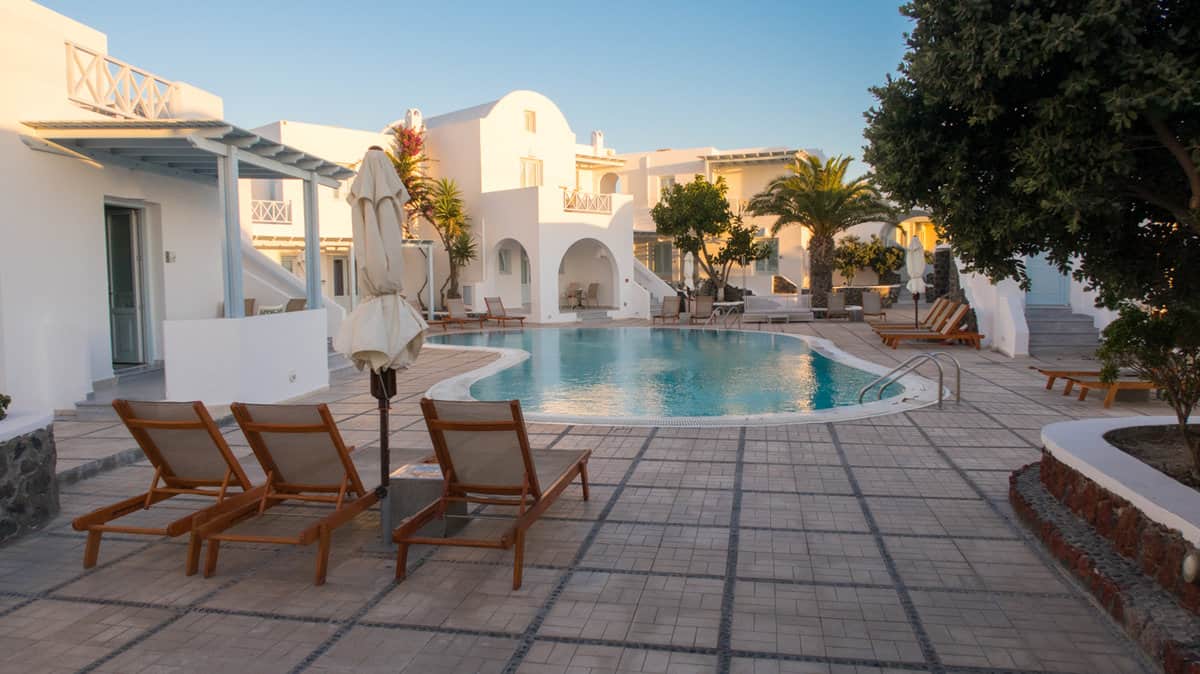
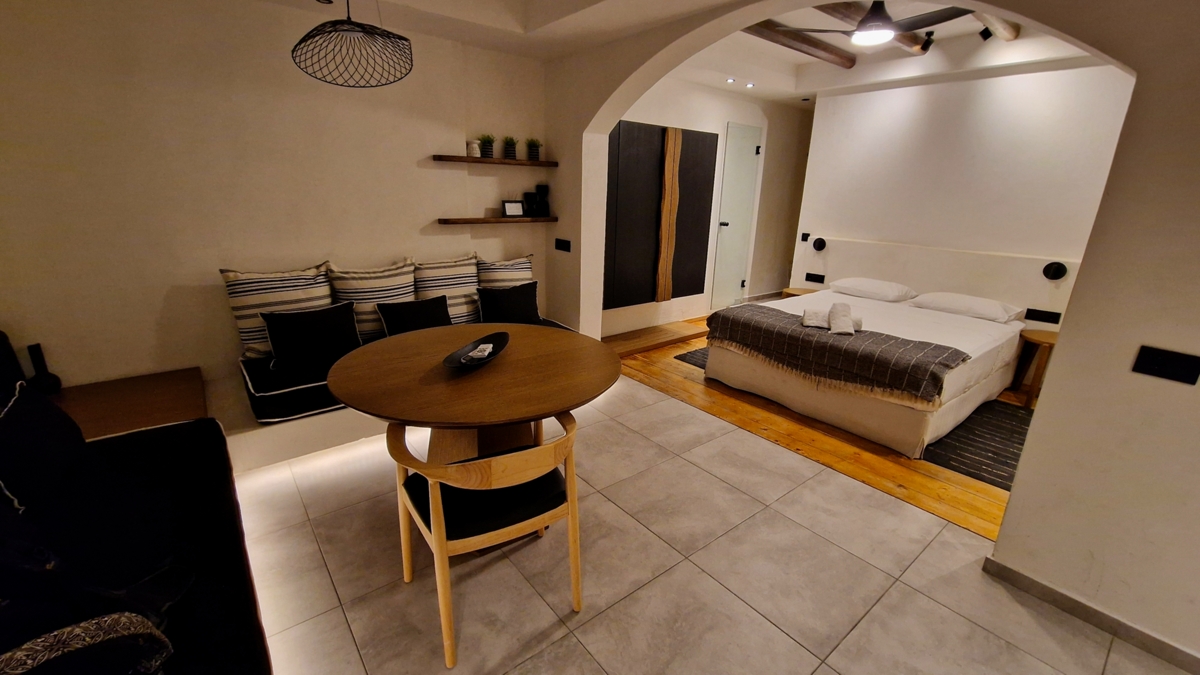







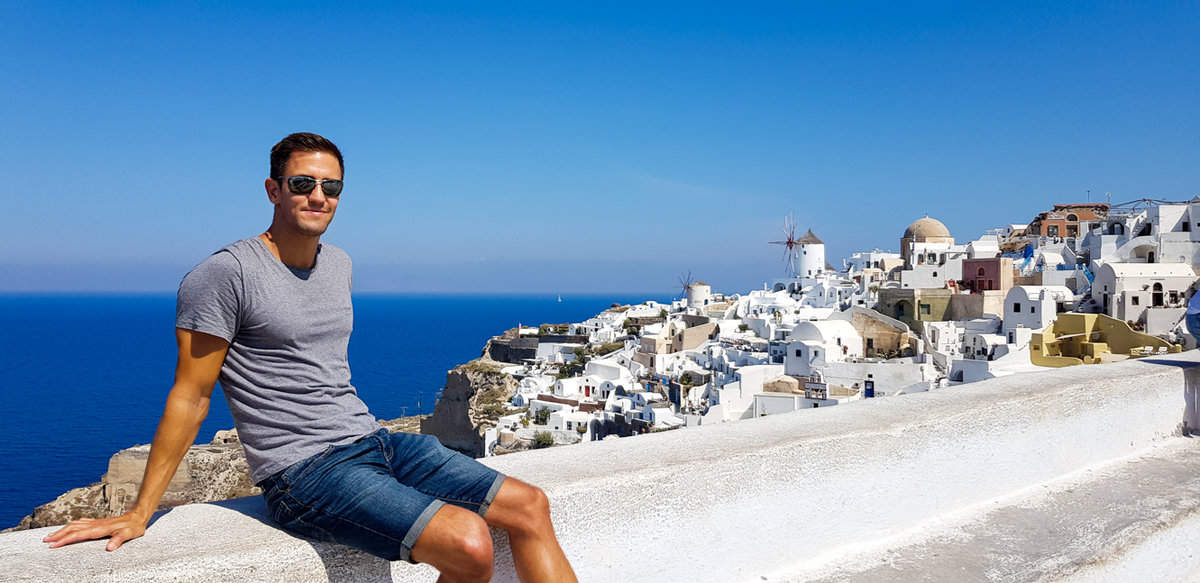
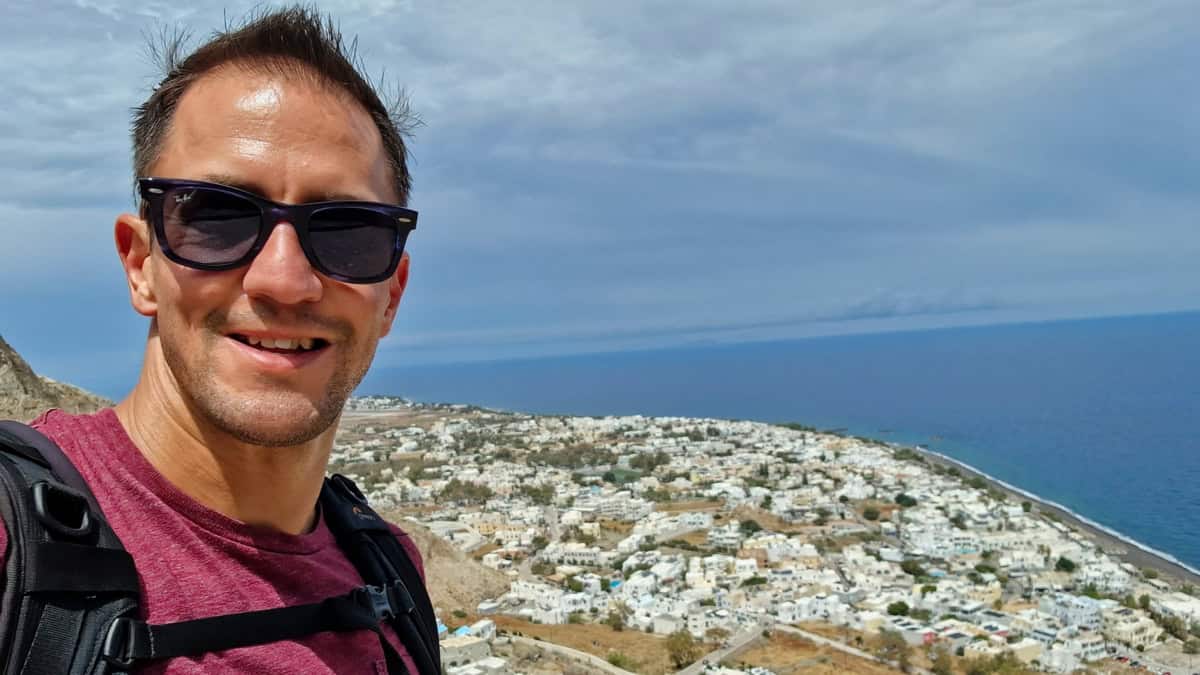

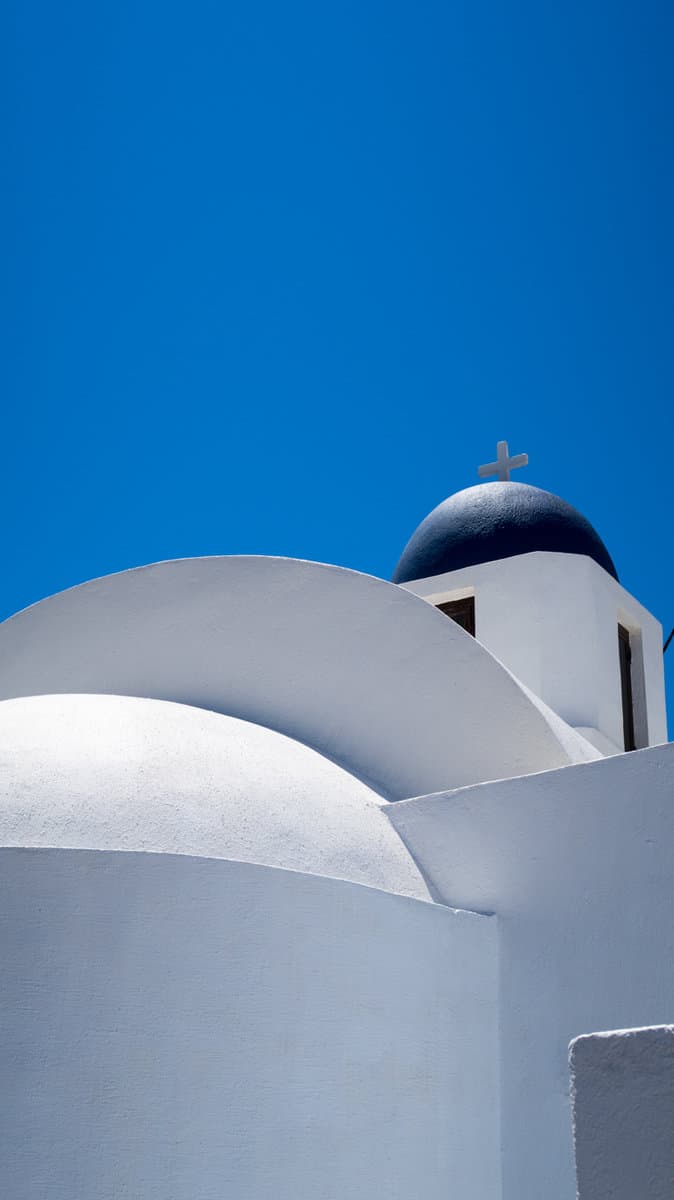
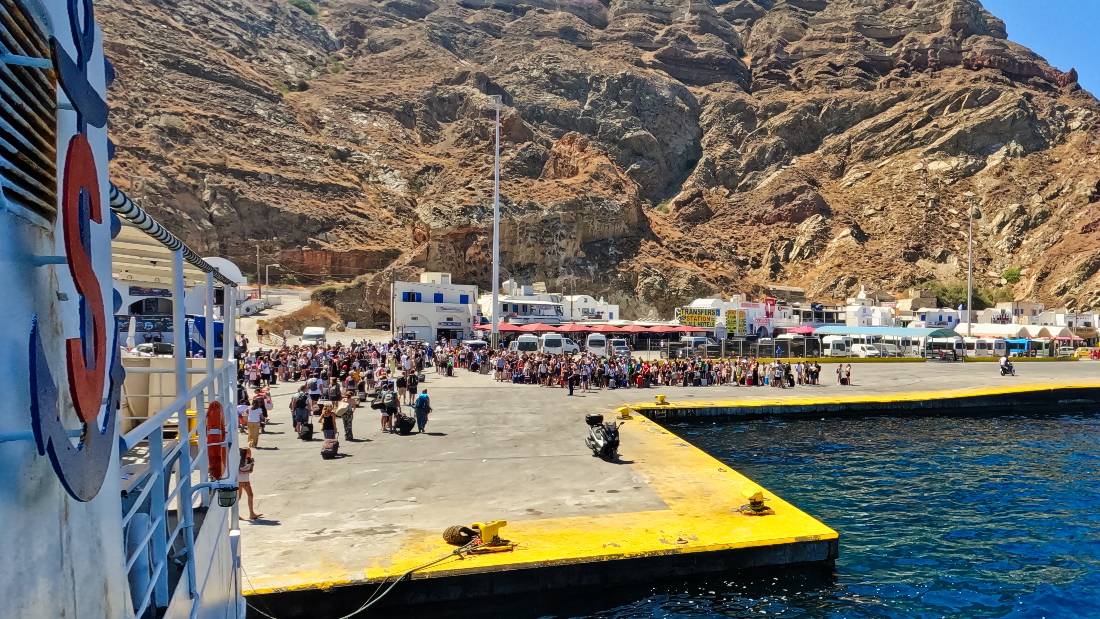

Getting to Santorini
Santorini (Thira) Airport (JTR)
Santorini has a decent international airport, renovated in 2021. It has regular connections to most major European airports and Athens airport for domestic transfers. The airport is on the island’s eastern side, just north of Kamari and south of Monolithos.
A regular bus service links the airport with the capital, Fira, but many people choose private transfers to reach their accommodation more quickly and in style. You can find taxis at the airport, too, but these can be in short supply when several flights arrive, and you could end up waiting a long time, so it’s best to pre-book a transfer or use the local bus.
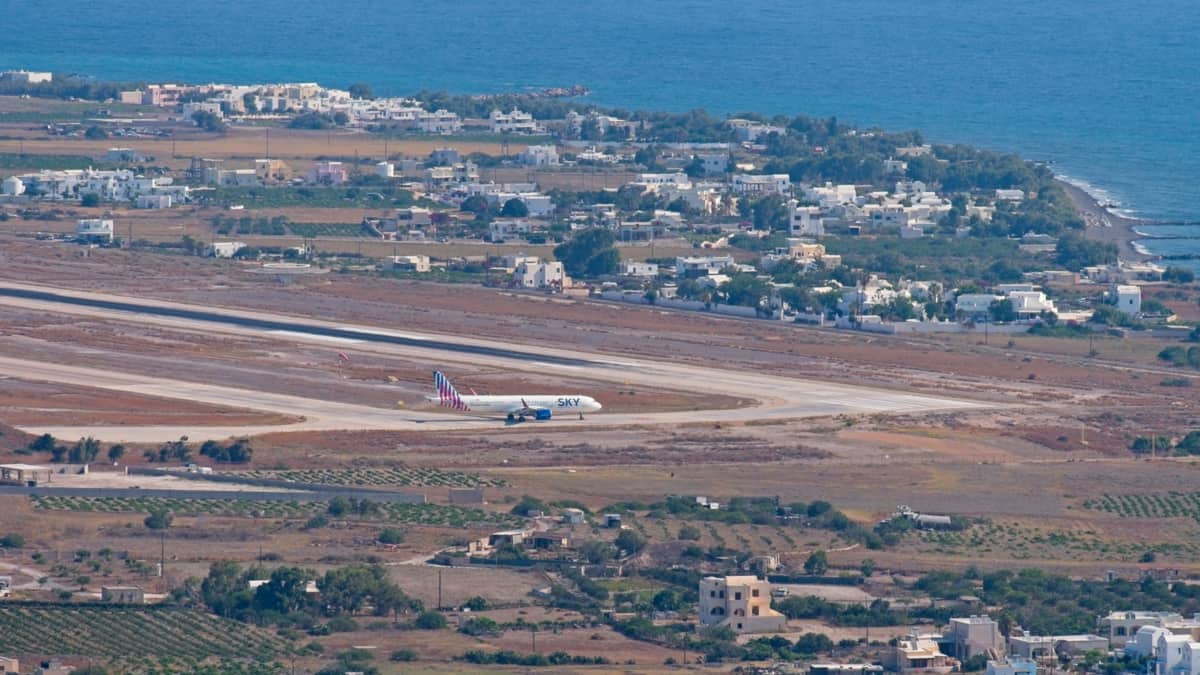
You can find flights to Santorini using Skyscanner or your preferred airline operator’s portal.
Athinios Ferry Port
The main port of Santorini, Athinios, is located at the bottom of the caldera down a steep switchback road approximately 8 kilometres south of the capital, Fira. Due to its distance from any nearby village and the steep path, trying to arrive or leave the port on foot is not recommended.
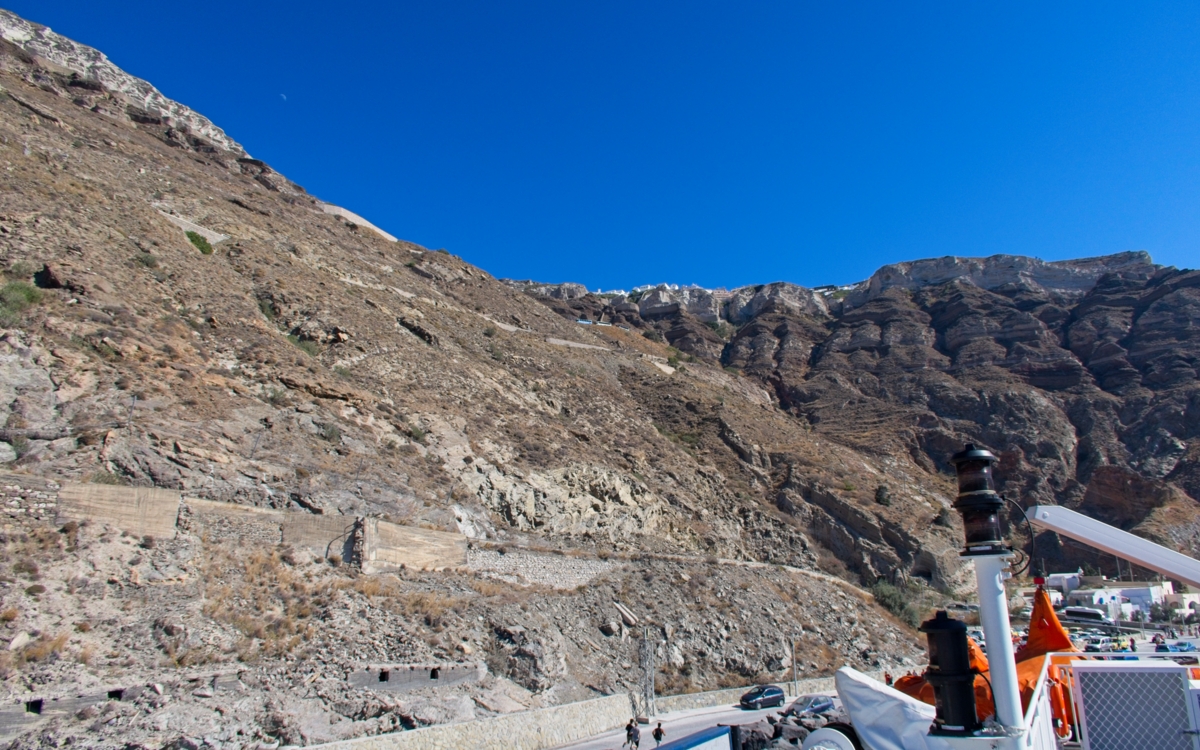
A local bus service meets every ferry and will take passengers to Fira, where they can find a connecting service to other resorts on the island. Alternatively, you can book private transfers or pick up a taxi – there is a taxi station at the port, though you may have to queue during busy times.
You can find out about ferry connections to Santorini on FerryHopper or use the booking widget below:

Where to Stay on Santorini
Santorini offers a wide range of accommodation to suit most budgets and tastes, from luxury caldera view suites with private pools to more modest studios and hotels away from the clifftops.
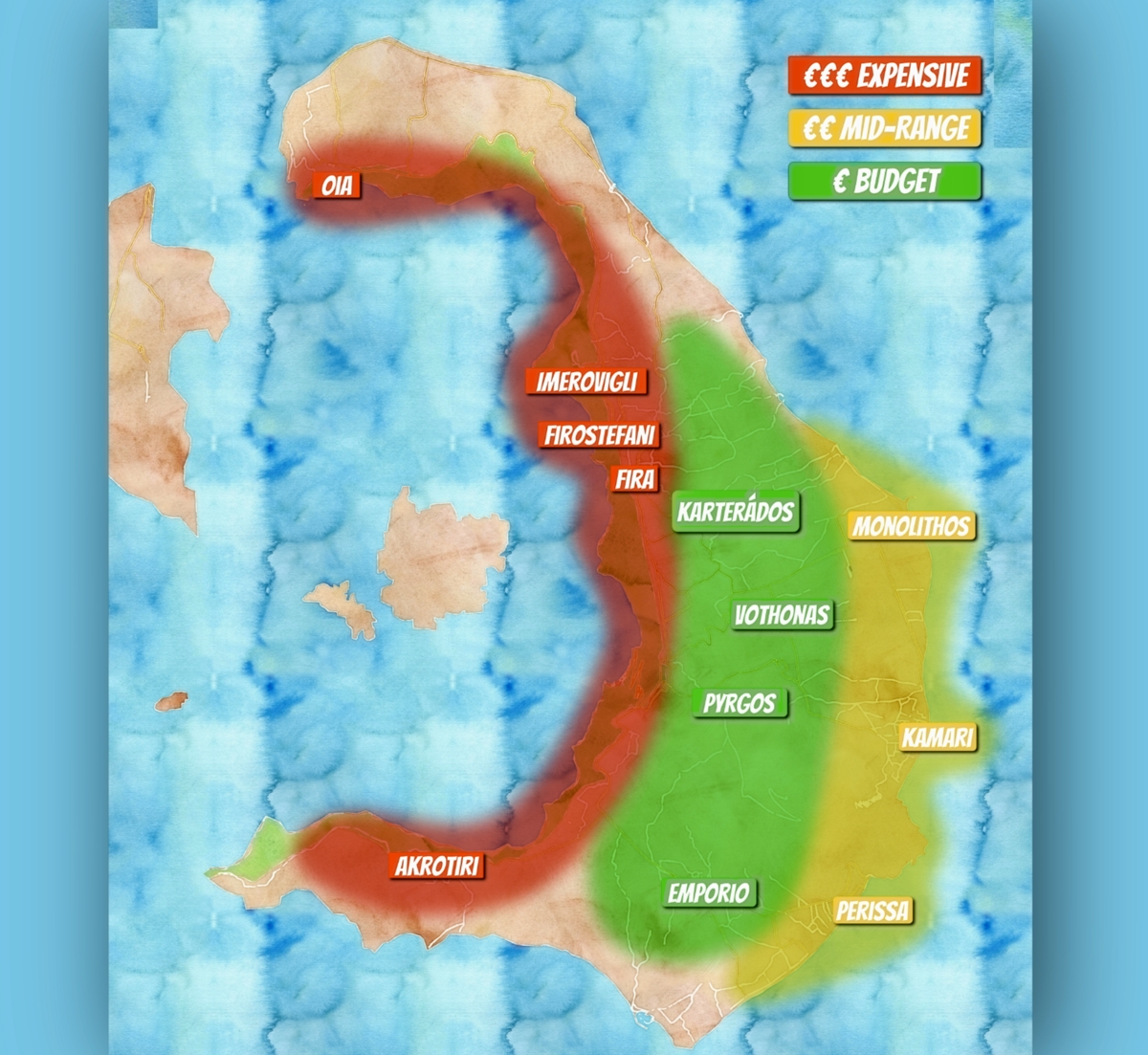
The above image shows a map of Santorini with several popular villages, highlighted to show typical relative costs for each area. As a guide, staying on the western side of the Caldera rim is the most expensive, followed by the eastern beach resorts. Inland villages are typically the cheapest. That’s not to say you can’t find cheap rooms near the caldera or luxury hotels elsewhere.
Fira, Firostefani & Imerovigli
The capital, Fira, and its two northern neighbours, Firostefani and Imerovigli, are the most popular resorts in Santorini due to their central location and proximity to local amenities such as the main bus station in Fira. Of the three, we recommend Imerovigli as it’s the quietest while still offering stunning views and convenient foot access to Fira. Firostefani is similar in many ways, but can get slightly more crowded as it’s closer to the capital. Staying in Fira itself is not recommended: it’s the busiest place on the island. This is partly because it’s where the cable car station delivers cruise ship passengers, flooding the village with tourists on any day when one or more ships are docked.
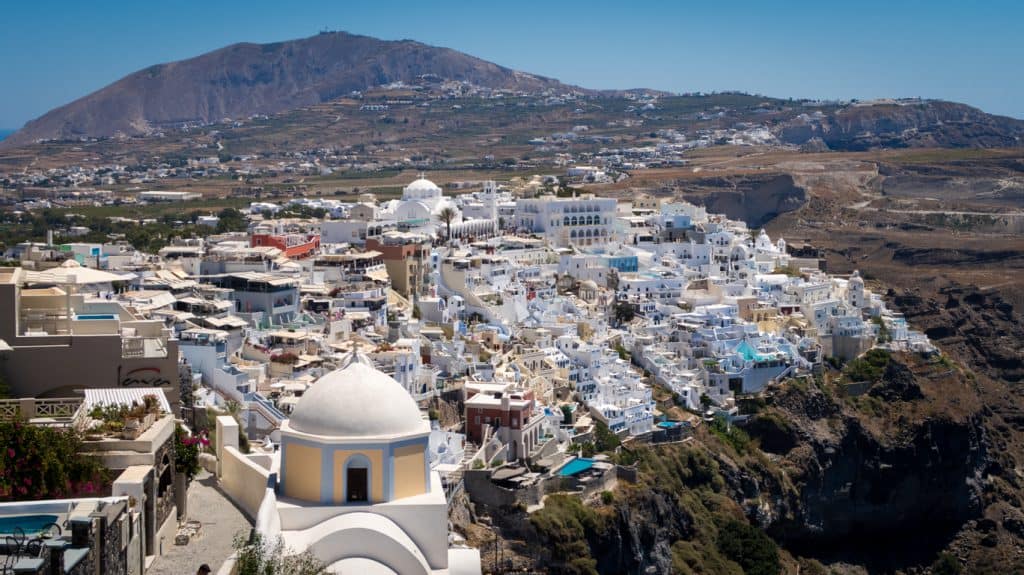
Oia
After Fira, Oia is the most popular village on the island. It is famous for its iconic sunset views, which draw thousands of visitors during the peak summer season. Oia offers a range of luxury and more modest accommodation, both on the caldera rim and towards the centre of the village. The closer to the centre and western side (where the sunset spots are), the more crowded it will be around your hotel, so it’s best to stay on the outskirts if you can or visit during quieter months when it won’t be as packed.
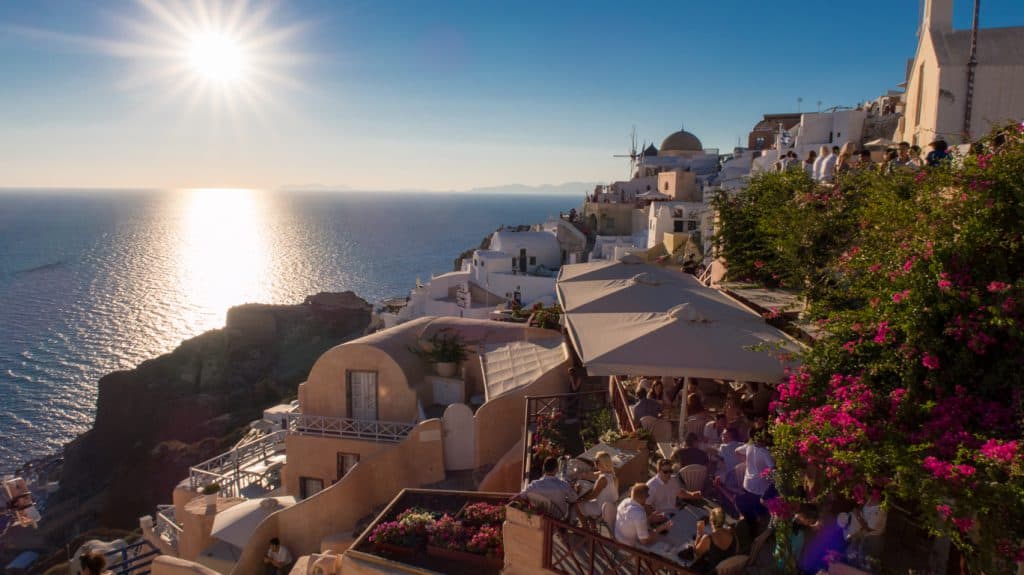
Akrotiri
Akrotiri is on the southern tip of Santorini, opposite Oia. More well known for its prehistoric village archaeological site, it’s becoming a more popular base as the other caldera resorts reach saturation point. You can find luxury hotels here with similarly impressive views and fewer crowds, so it’s definitely worth considering as a great place to stay.
Perissa & Kamari
If you aren’t desperate to have the iconic clifftop views on your doorstep (they are just as impressive regardless of how you get to them), good alternatives are the beach resorts along the eastern coastline of Santorini. Kamari and Perissa are the two most popular villages and have a more typical Greek island vibe than you’ll find elsewhere. We stayed in Kamari twice, either side of a trip to Ios, back in 2023 and found it a pleasant, relaxing and friendly resort with a wide selection of restaurants, shops and beachfront cafes/bars. Prices were only slightly above what you’d find on other islands, too, and much cheaper than in Fira and Oia.
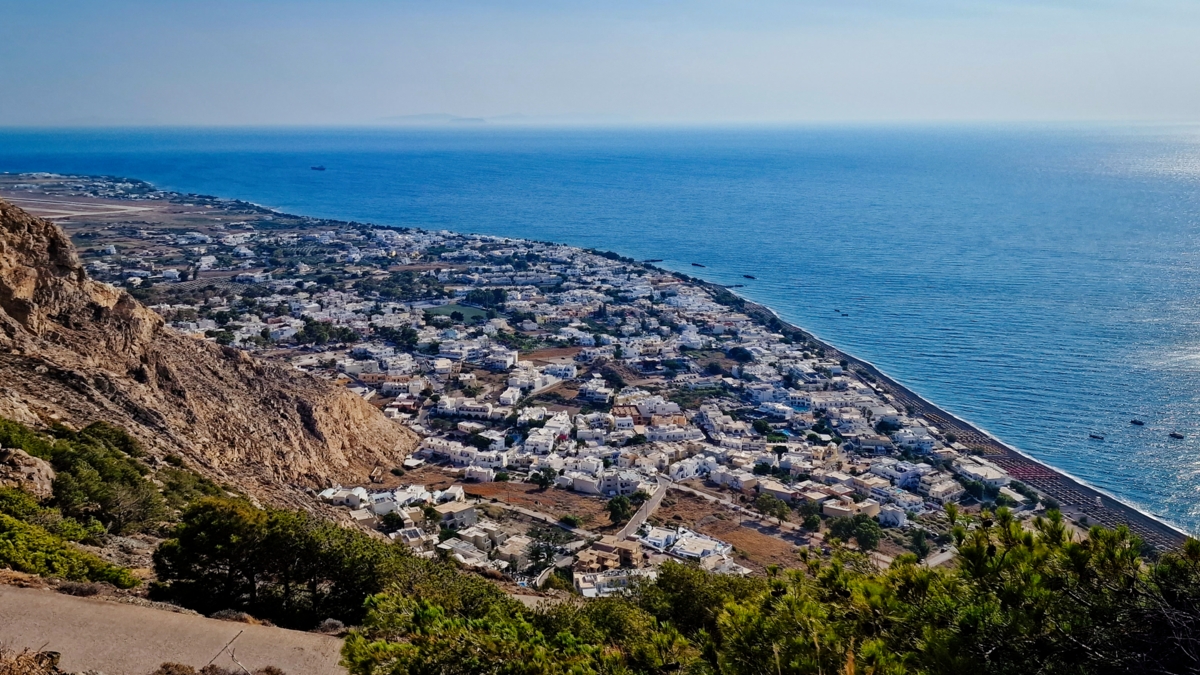
Emporio, Prygos, Vothonas and Karterádos
For those not interested in clifftop views or beach proximity, the best accommodation deals are found inland at one of the many smaller villages, such as Emporio, Vothonas, Pyrgos, or Karterádos. You’ll typically find that each village is on at least one bus route, allowing you access to Fira (where all buses start and finish their routes) within 10-20 minutes. We spent two nights in Karterádos in May 2024 and found it an ideal base, with the main bus station in Fira just a 15-minute walk from our hotel and a bus stop right outside that most buses pass on their way back to the capital. Our accommodation, Hotel Lodos, cost just under €50 per night.
Things to see and do on Santorini
Explore the Stunning Landscape
One of Santorini’s main attractions is its dramatic landscape. The island was formed by a massive volcanic eruption over 3,500 years ago, and its cliffs and rugged terrain provide a breathtaking backdrop for any visit. The island’s famous caldera, a giant volcanic crater filled with crystal-clear waters, is a must-see attraction that offers stunning views of the Aegean Sea.
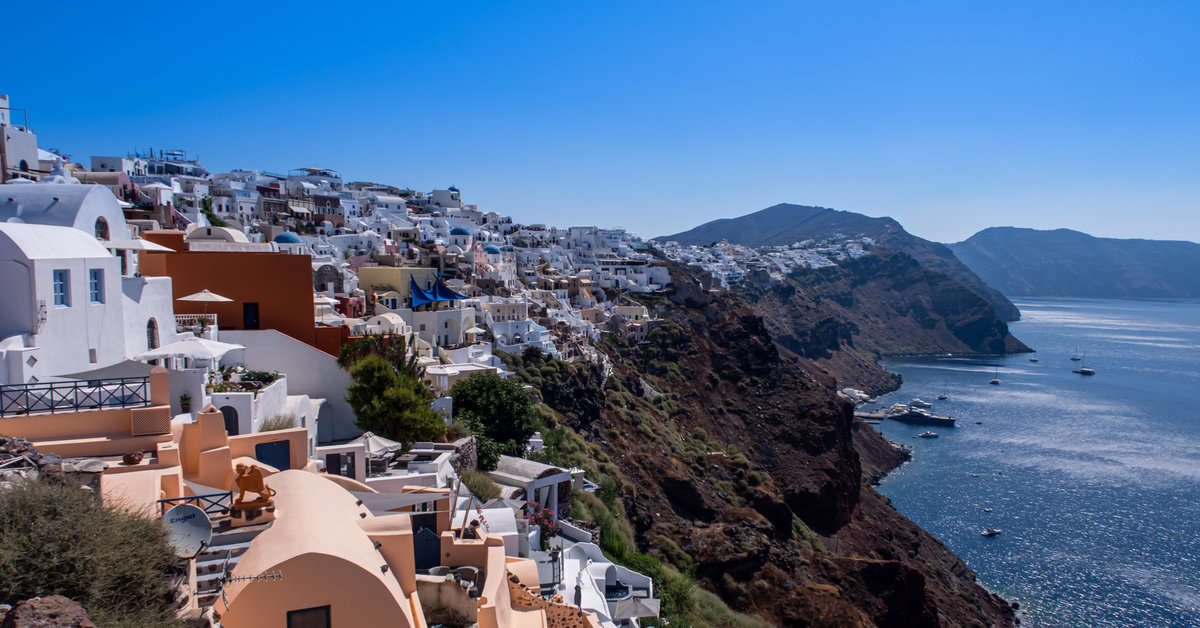
Santorini is also known for its beautiful villages, each with unique charm and character. The most famous is Oia, a picturesque village famous for its blue-domed churches and stunning sunsets. Visitors can stroll through the village’s narrow streets and explore its many shops and galleries, which offer traditional Greek crafts and souvenirs.
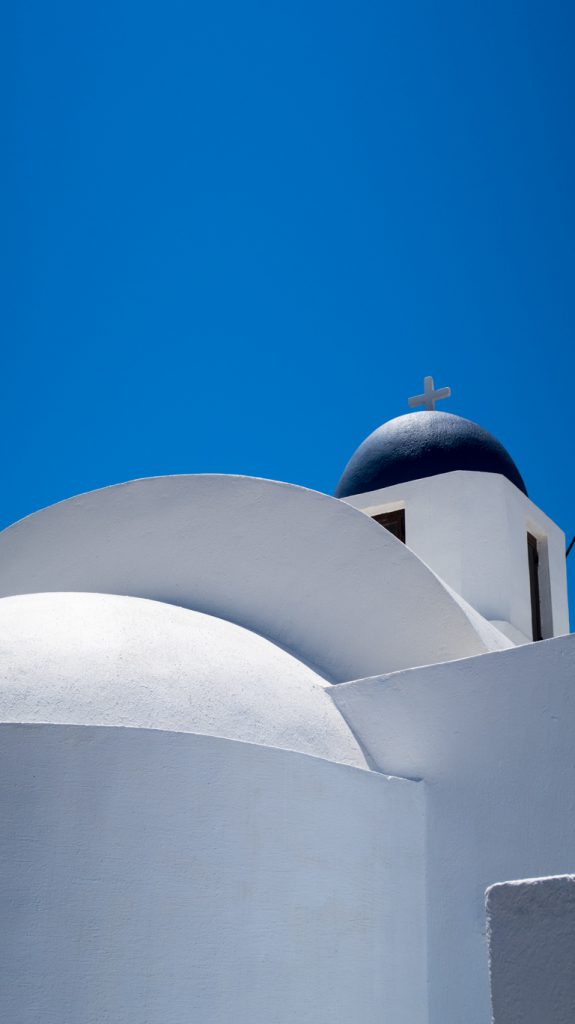
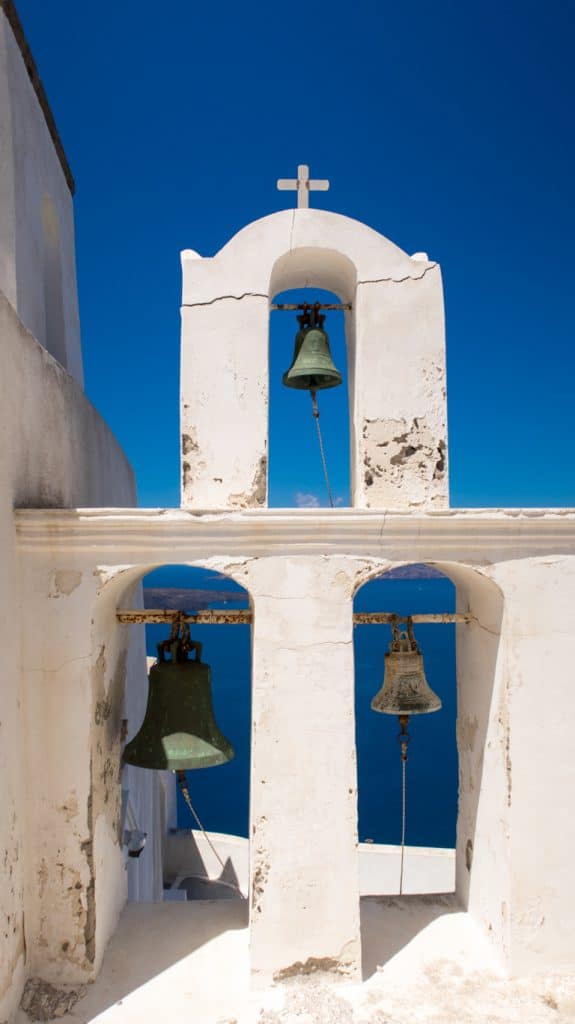
Wine Tasting / Tours
Santorini’s volcanic soil and sun-drenched climate create the perfect recipe for some of Greece’s most celebrated wines. For centuries, the island’s winemakers have coaxed unique flavours from the land, most famously the crisp, mineral-rich Assyrtiko — a white wine that captures the essence of Santorini in every glass.
Exploring the island’s wineries is a true highlight for visitors. Scattered across the sunbaked landscape, many vineyards offer tours where you can wander among ancient basket-trained vines, learn about Santorini’s centuries-old winemaking traditions, and, of course, sample the results with a view of the endless Aegean. From bright whites to the sweet, amber-hued Vinsanto, every sip tells a story of resilience, history, and the island’s enduring spirit.
We chose to visit Estate Argyros during our stay in 2024 and thoroughly enjoyed the tour and tasting experience.

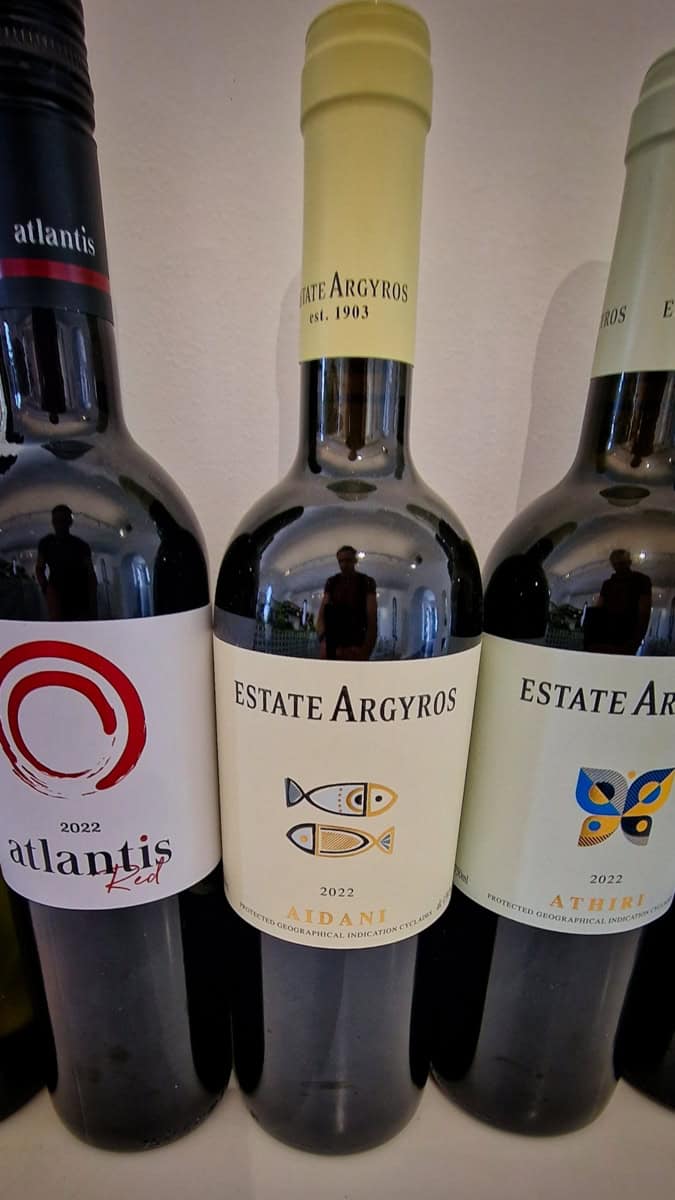
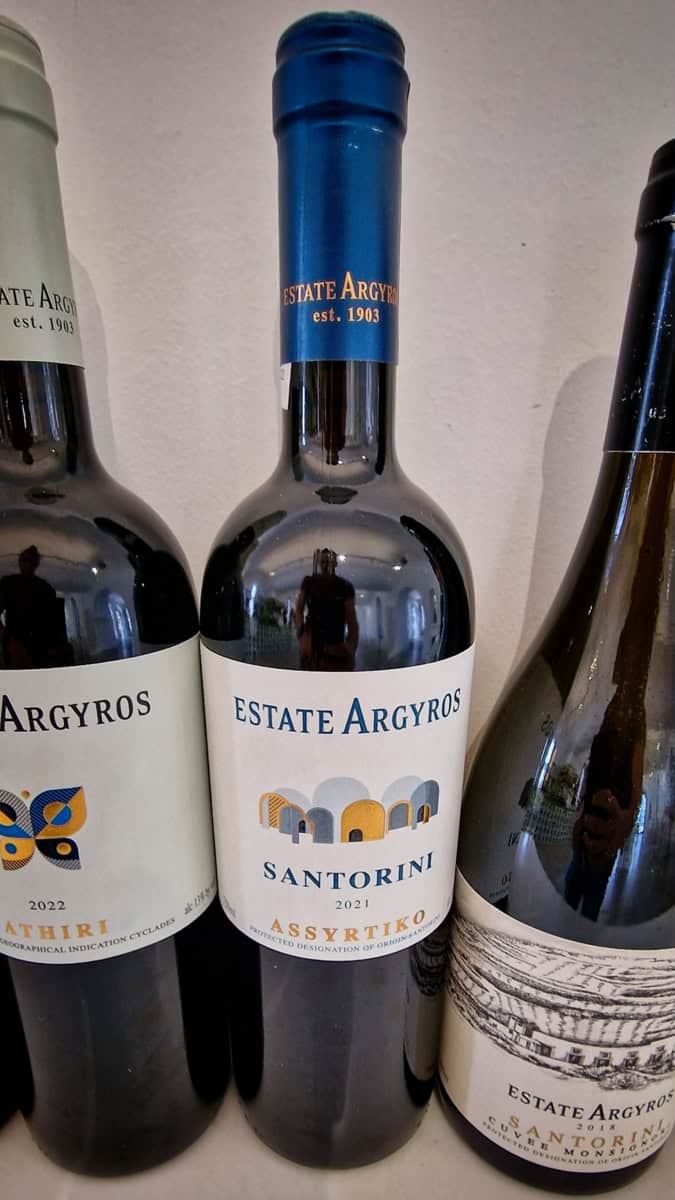
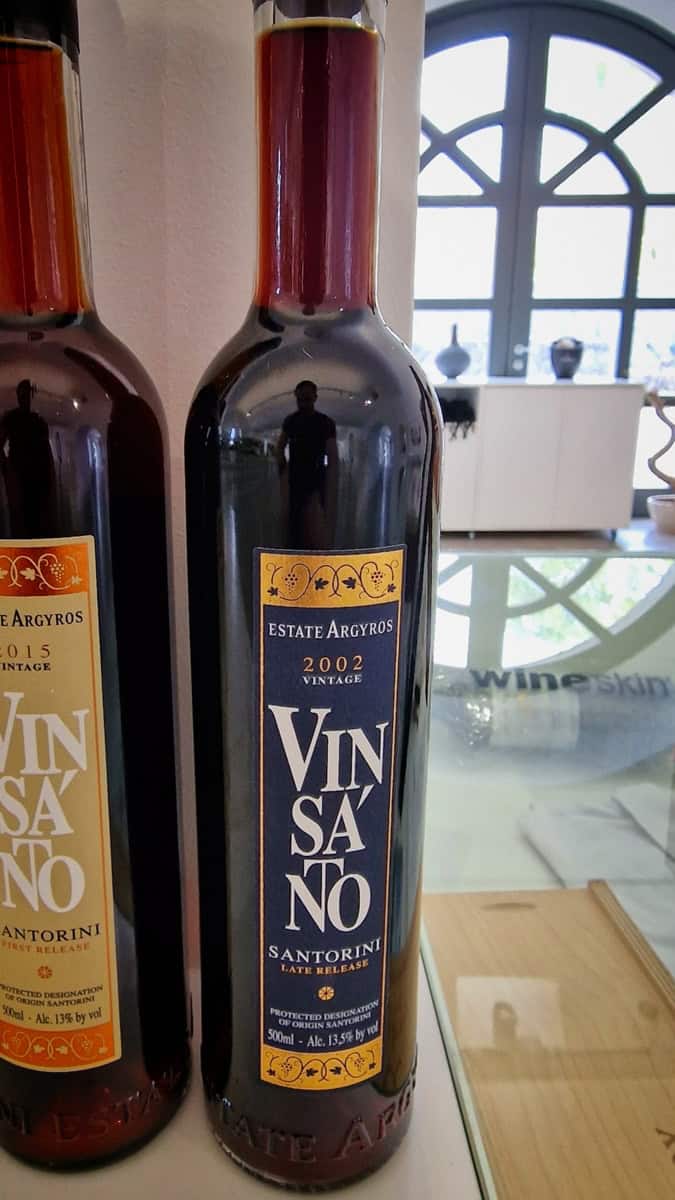
Historic Sites
Santorini has two main historic attractions: Akrotiri and Ancient Thera. At Akrotiri, often called the “Minoan Pompeii,” you’ll step into a remarkably preserved Bronze Age settlement, frozen in time by a volcanic eruption around 1600 BC. Wander through the ancient streets, past multi-story buildings, vibrant frescoes, and pottery that hint at a once-thriving, sophisticated civilisation. It’s a haunting, beautiful reminder of the island’s powerful history. Be sure to visit the Museum of Prehistoric Thera in the island’s capital, Fira, to see some of the impressive artefacts excavated from Akrotiri.
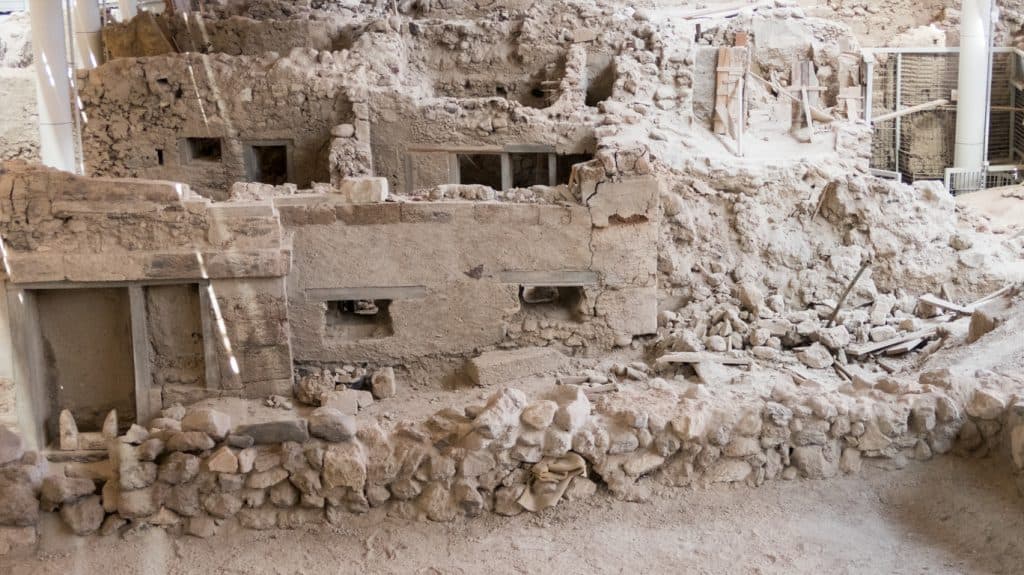
High above the beaches on Mesa Vouno mountain, the ruins of Ancient Thera offer another journey into the past — this time to the days of Greek and Roman rule. As you explore temples, marketplaces, and houses, the panoramic views over the island are as breathtaking as the history itself. Visiting both Akrotiri and Ancient Thera paints a vivid picture of Santorini’s rich, layered story — one shaped by both human ambition and nature’s untamed force.
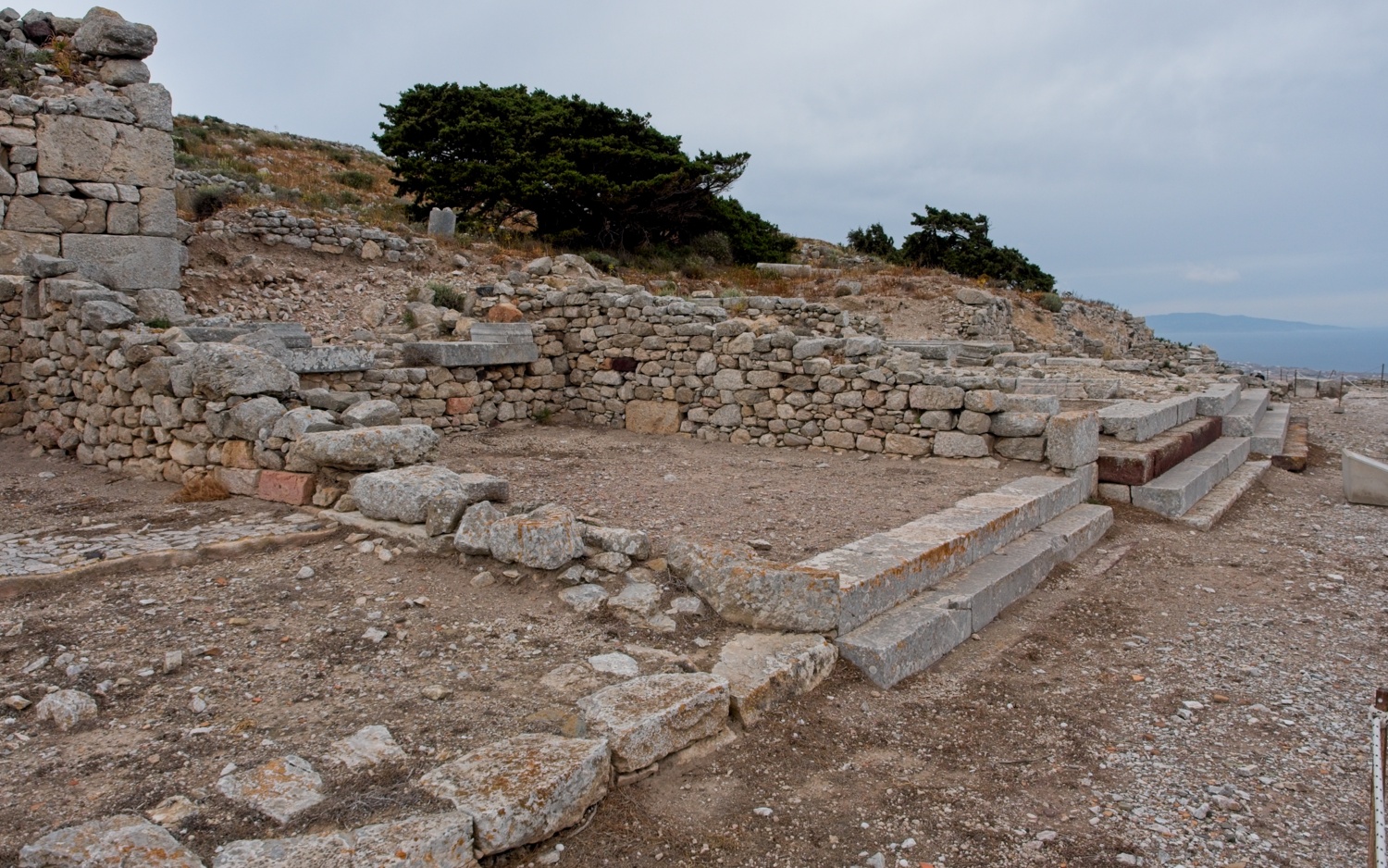
Santorini Nightlife
Although most visitors don’t come here for the nightlife, when the sun dips below Santorini’s famous caldera, the island transforms into a vibrant playground of music, cocktails, and unforgettable moments. From chic rooftop bars offering stunning sunset backdrops to lively clubs pulsing with energy, Santorini’s nightlife scene has something for every traveller.
In Fira, the island’s buzzing capital, you’ll find an exciting mix of stylish lounges, traditional tavernas, and late-night clubs. Start your evening with a glass of local Assyrtiko wine at a cliffside bar, where breathtaking sunset views set the perfect tone. As the night deepens, spots like Koo Club and Enigma take centre stage, offering dance floors that stay alive until sunrise.
If you prefer something a little more laid-back, head to Oia for sophisticated wine bars and relaxed cafes where the atmosphere is all about charm and conversation.
Whether you’re chasing a glamorous night out or a cosy evening of live music by the sea, Santorini’s nightlife promises memories as magical as its legendary sunsets.
Santorini Beaches
If you’re expecting soft golden sands and gentle turquoise waves, you might want to reset your expectations — Santorini does beaches its own way. Thanks to its volcanic roots, this island swaps golden shores for dramatic black sands that can get seriously hot under the summer sun (trust us, you’ll want those beach sandals).
The island’s wild western edge is all towering cliffs and jaw-dropping caldera views — beautiful, but not exactly beach-friendly. For that, you’ll need to hit the east coast, where places like Kamari and Perissa deliver the full Greek beach package: sunbeds, chilled-out tavernas, and beach bars just steps from the water, all set against a backdrop of dark volcanic sand.
Feeling adventurous? Head down to the famous Red Beach near Akrotiri. With its deep red cliffs and Martian-like landscape, it’s one of Santorini’s most Instagrammable spots. Just keep in mind, rockfalls are a real thing here — the warning signs aren’t just for show — but that hasn’t stopped plenty of visitors from making the climb for that perfect photo.
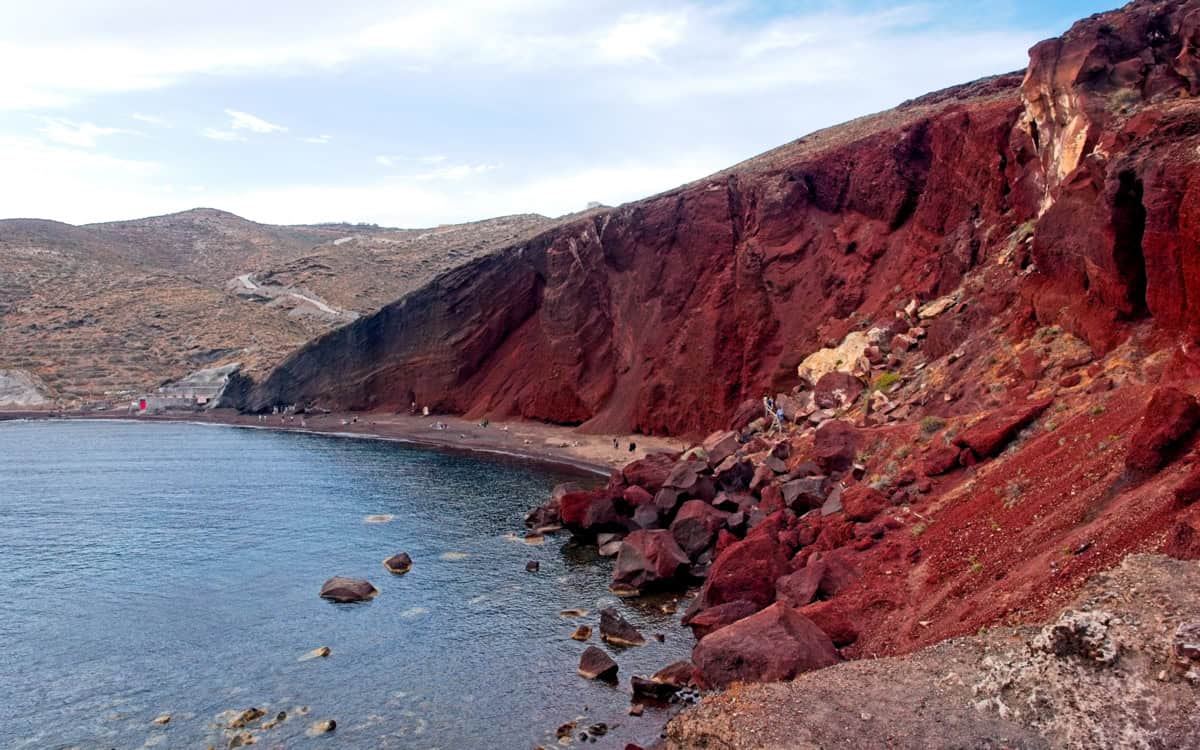
Santorini Accommodation
Santorini offers a wide spectrum of accommodation, from luxurious cliffside suites to affordable beachside studios. Whether you’re visiting for a honeymoon, a family holiday, or a solo adventure, the island has a style of stay to match your travel goals. Below are some of the best types of accommodation available on Santorini, along with specific recommendations based on first-hand experience and guest popularity.
✨ Luxury Cave Suites & Caldera View Hotels
For the ultimate Santorini experience, nothing beats a cave-style suite carved into the caldera cliffs, complete with a private plunge pool or hot tub and uninterrupted sunset views. These accommodations are perfect for couples or honeymooners looking for privacy and indulgence.
Recommended stays:
- Canaves Oia Suites – Iconic luxury with flawless service, infinity pools, and panoramic views.
- Katikies Hotel – Elegant, whitewashed architecture and renowned for its romantic atmosphere.
- Astra Suites (Imerovigli) – Stylish suites with spacious terraces and a peaceful vibe, ideal for those avoiding Oia’s crowds.
🏖️ Boutique Hotels & Beach Resorts
On Santorini’s eastern side, you’ll find a very different but equally rewarding experience — boutique hotels near the beach. These offer stylish design, pools, and close proximity to the sea, often at better value than caldera-side options.
Recommended stays:
- Santorini Crystal Blue (Kamari) – A chic beachfront boutique hotel with elegant rooms and a laid-back vibe.
- Meltemi Village Hotel (Perissa) – Great for families or groups, with multiple pools and easy beach access.
- La Bellezza Eco Boutique Hotel (Kamari) – Eco-conscious design and a peaceful setting near the shore.
💰 Budget-Friendly Guesthouses & Studios
For travellers on a tighter budget, Santorini still offers excellent value if you’re willing to trade caldera views for convenience or a beach setting. Many family-run guesthouses and self-catering studios offer comfortable, clean, and welcoming accommodation without the luxury price tag.
Recommended stays:
- Villa Manos (Karterados) – Affordable, friendly, and just a short walk or drive from Fira.
- Hotel Marybill (Perissa) – Simple but well-maintained, with a pool and great access to the beach.
🏡 Traditional Villas & Boutique Stays in Village
For a more intimate, authentic experience, consider staying in a traditional villa or restored village house. Often located in quieter inland villages, these properties offer charm, privacy, and a slower pace of island life.
Recommended stays:
- Vedema, a Luxury Collection Resort (Megalochori) – Spacious suites in a vineyard setting with top-notch service.
- White Orchid Cave House (Emporio) – A tastefully renovated cave home, perfect for couples seeking peace and character.
🧳 Family-Friendly Hotels & Apartment Suite
Families visiting Santorini often prefer apartment-style hotels or larger suites with kitchenettes, pools, and space to spread out. Beach resorts tend to be more child-friendly, but some caldera-view properties also cater to families with larger units and quieter environments.
Recommended stays:
- Anassa Deluxe Suites (Kamari) – Spacious, family-oriented suites near the beach with a pool and warm hospitality.
- Dream Island Hotel (Fira) – Centrally located, with a pool and family rooms within walking distance to town.
From cliffside romance to beachfront relaxation and traditional village charm, Santorini’s accommodation options are as memorable and diverse as the island itself—whether you’re splurging on luxury or travelling smart on a budget.
Santorini Hotel Reviews
Below you’ll find reviews of the accommodation we’ve stayed at on our visits to Santorini. Click the links to read the full review.
Santorini Video Guide
Check out our video guide on Santorini, released in June 2024, which has tons of useful information about the island if you’re thinking of visiting:
Getting Around Santorini
Buses
Santorini’s bus network is comprehensive and frequent, though it can suffer from excess demand in peak season between mid-June and early September. Buses are cheap and generally cost from €1.60 to €2.40, depending on the destination. Bus tickets are purchased on the bus after you’ve boarded – a collector will come down the bus once it’s moving and take money.
The most important thing to know about buses in Santorini is that all routes run to and from the capital, Fira. The main bus station is located to the south of the village, down a short road opposite the Museum of Prehistoric Thera. An information kiosk guides tourists on which buses to take to reach various destinations. Buses typically have signs in the front window stating which village or resort is their main destination, but in all cases, the buses are numbered, and the kiosk will tell you which number bus you need.
The drivers and ticket sellers typically shout their destination to waiting passengers shortly before departure, so if you don’t want to use the kiosk, listen out for shouts about the destination you’re after and check with the driver when you board.
Most villages have one or more bus stops, which are usually well-signposted and should have the most up-to-date timetable printed nearby. If you want to get off at a particular stop before the bus reaches its destination, tell the ticket seller, and they should make sure the bus stops where you want it. Often, the stops are called out as the driver approaches, so you can also respond by saying you want to get off at that stop. In some cases, the buses are fitted with stop buttons you can use as an alternative to shouting.
Cars, Motorbikes and ATVs
If you prefer to have your own private transportation for some or all of your time in Santorini, you’ll find lots of rental companies at the airport and in most villages offering cars of varying sizes, as well as bikes/mopeds and ATVs (quad bikes). Unless you’re familiar with Greek roads, we don’t recommend mopeds or ATVs as they can be dangerous and local drivers aren’t always the most sympathetic towards tourists on the road, especially the local bus drivers. Cars are the safest option and often cost only slightly more than an ATV while offering secure storage, room for 4 or 5 people and air conditioning. Expect to pay at least €15 per day for mopeds and €30 or more per day for cars and ATVs, with prices increasing for larger models. Try shopping around to negotiate the best deals, but most companies will charge similar amounts, and due to high demand, you are unlikely to get much discount during peak season.
Cuisine
Santorini is a food lover’s paradise, with numerous restaurants that offer traditional Greek cuisine and international dishes. The island’s volcanic soil is ideal for growing grapes, and its wines are renowned worldwide. Visitors can sample the island’s delicious wines and enjoy a meal of fresh fish and seafood in one of the many tavernas that line the island’s coast.
Santorini: Conclusions and Alternatives
I first visited Santorini in 2017 during my initial island-hopping adventure. It was a must-see on my north-south itinerary, though I approached it with some hesitation due to its reputation for being pricey and overcrowded. I wasn’t sure what to expect as someone who enjoys quieter, more traditional Greek islands.
After spending three days soaking in the island’s beauty, I left for Crete with mixed feelings. The caldera views were unforgettable, and the meals were delightful. Navigating the island was relatively easy, but the crowds were the densest I’d encountered in Greece.
If you’re on the fence about visiting Santorini, take heart. I’ve returned three times since that initial trip and haven’t regretted it once. In 2019, my girlfriend and I stayed in Firostefani on the caldera rim, enjoying a fantastic time at a modest hotel with incredible views. I experienced a different side of the island in 2023, staying in Kamari at the start and end of a trip to nearby Ios. In May 2024, I had a brief but highly enjoyable stay in Karterados, where I ticked off new activities like visiting a winery and hiking from Fira to Oia.
Despite its popularity and the unavoidable crowds, Santorini is an island that deserves a spot on everyone’s bucket list. Its unique geography offers breathtaking views that can’t be fully captured in photos or videos. Santorini is a destination you’ll remember forever.

While there’s no place quite like Santorini, Milos comes closest with its shared volcanic origins. You won’t find the same caldera-rim views, but you will get a much broader selection of beaches, sightseeing opportunities and traditional Greek villages. It’s quieter than Santorini, too, but still one of the more popular Greek Island destinations. (Don’t let the mainstream media’s ‘hidden gem’ label fool you, Milos has been on the tourist map for several years now.)
If you fancy somewhere with a bit more contrast, consider Ios. Just a short ferry ride north of Santorini, it’s an island of two opposites: traditional Greek charm and pulsating nightlife. The latter is optional, of course, so if you just want to relax on some of Greece’s finest beaches without a hangover, check it out.
A third alternative is nearby Folegandros. Unlike Milos, it does have a clifftop Chora not entirely unlike Santorini’s capital, just on a much smaller scale. You’ll find far fewer tourists here, and it does lack a bit in terms of beaches and sightseeing, but as a destination to relax and unwind, you could do a lot worse.
Santorini Blog Posts
Find out more about Santorini by reading our recent blog posts:
-
Top 5 Greek Islands for 2025
Introduction If you’re dreaming of a trip to Greece but don’t know which islands to visit, you’re in the right place. In this article, we’re sharing our top five must-visit
-
Travelling from Fira Santorini to Ios
This post is part of a series called Ios 2024 Sunday 21st July 2024 My Journey Continues My time in Santorini was intentionally short, having visited as recently as May
-
Manchester to Santorini (Amid Global IT Outage Chaos)
This post is part of a series called Ios 2024 Saturday 20th July 2024 A Nervous Start On the day before my trip, a global internet outage disrupted millions of
-
Day 50: Ios to Crete
This post is part of a series called Greece 2022 Sunday 7th August 2022 Introduction: Moving on Again I’ve spent a glorious week here on Ios, but once again it’s
-
Day 4: Santorini to Folegandros
This post is part of a series called Cyclades 2019 Tuesday, 16th July 2019 After a later-than-usual breakfast, I checked with the reception that they could organise a transfer to
-
Day 3: Oia and Kamari
This post is part of a series called Cyclades 2019 Monday, 15th July 2019 Our original plan had been to visit Oia the previous evening to watch the sunset. But,
-
Day 2: Firostefani
This post is part of a series called Cyclades 2019 Sunday, 14th July 2019 Even after our late arrival the night before, we refused to let precious hours slip away.
-
Day 1: Flying into Santorini
This post is part of a series called Cyclades 2019 Saturday, 13th July 2019 Our outbound flight for this trip was with Norwegian Air, a 5:20 p.m. departure from Gatwick
-
Day 15: Santorini to Malia, Crete
This post is part of a series called Cyclades Island Hopping 2017 Today is my last day in Santorini, and with my ferry to Crete not departing until 5:30 p.m.,
-
Day 14: Exploring Santorini, Fira, Museums, and Oia
This post is part of a series called Cyclades Island Hopping 2017 I had a bit of a lay-in this morning and didn’t get to breakfast until about 9 am.
Santorini Accommodation – Santorini Blog

